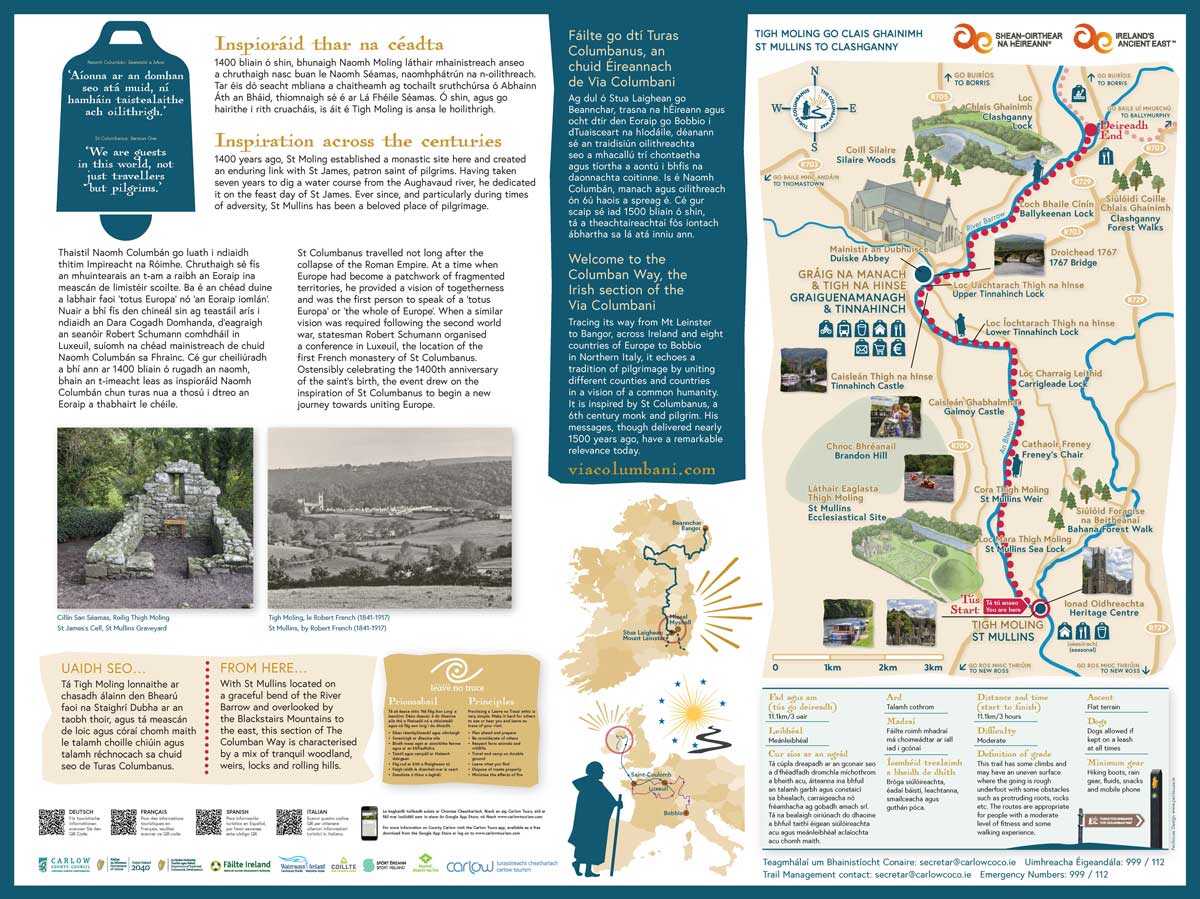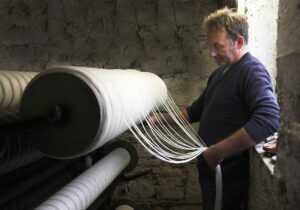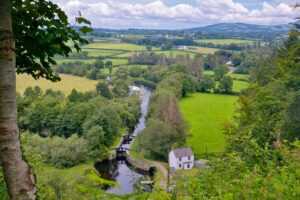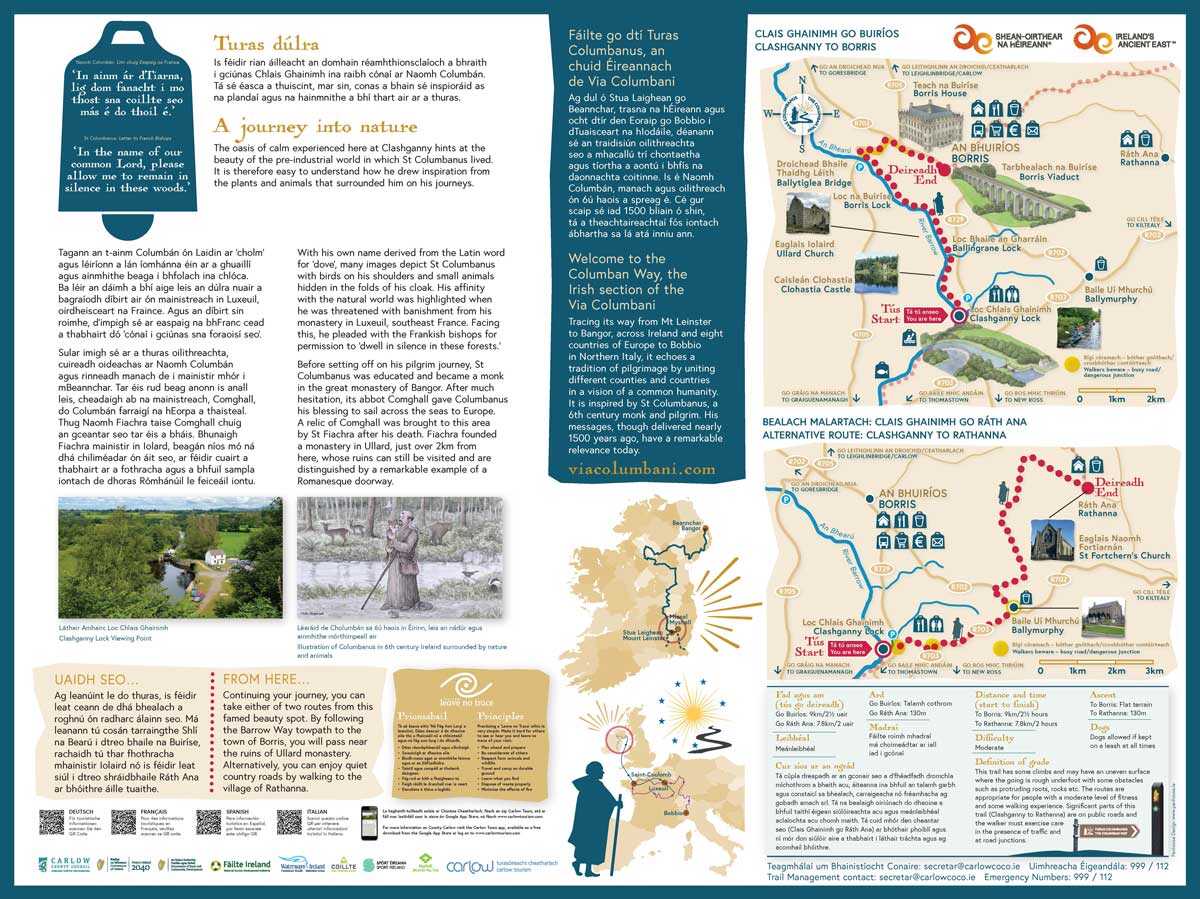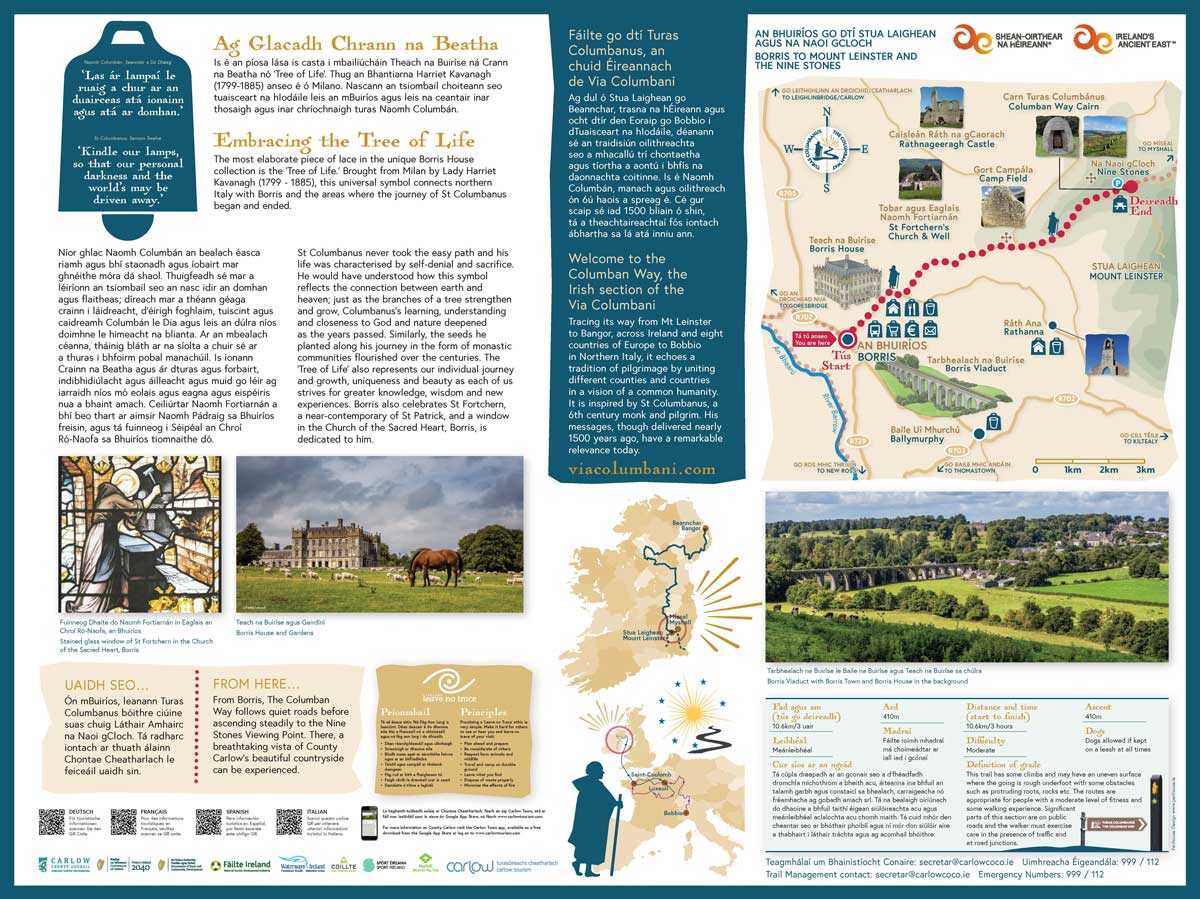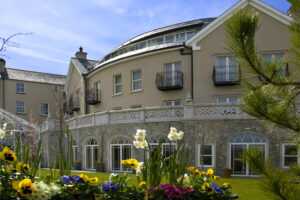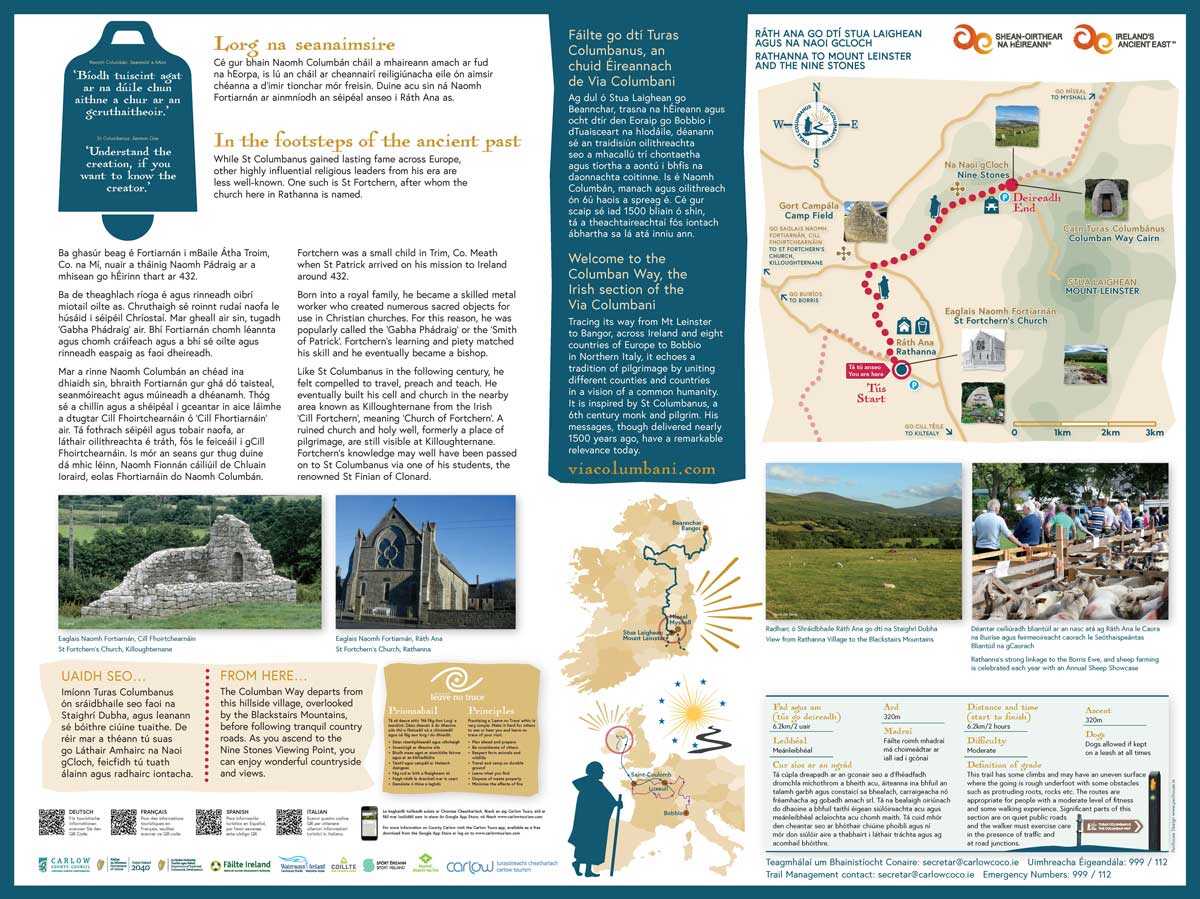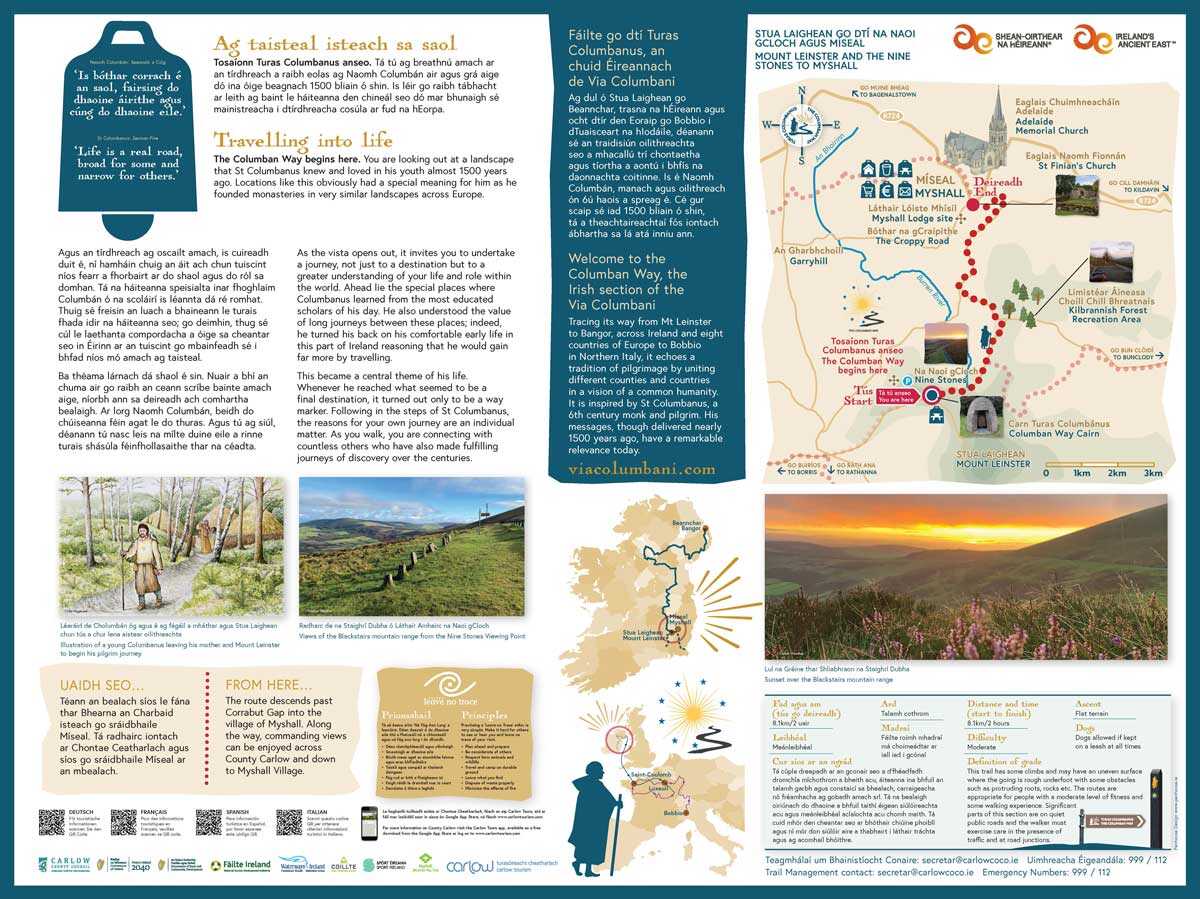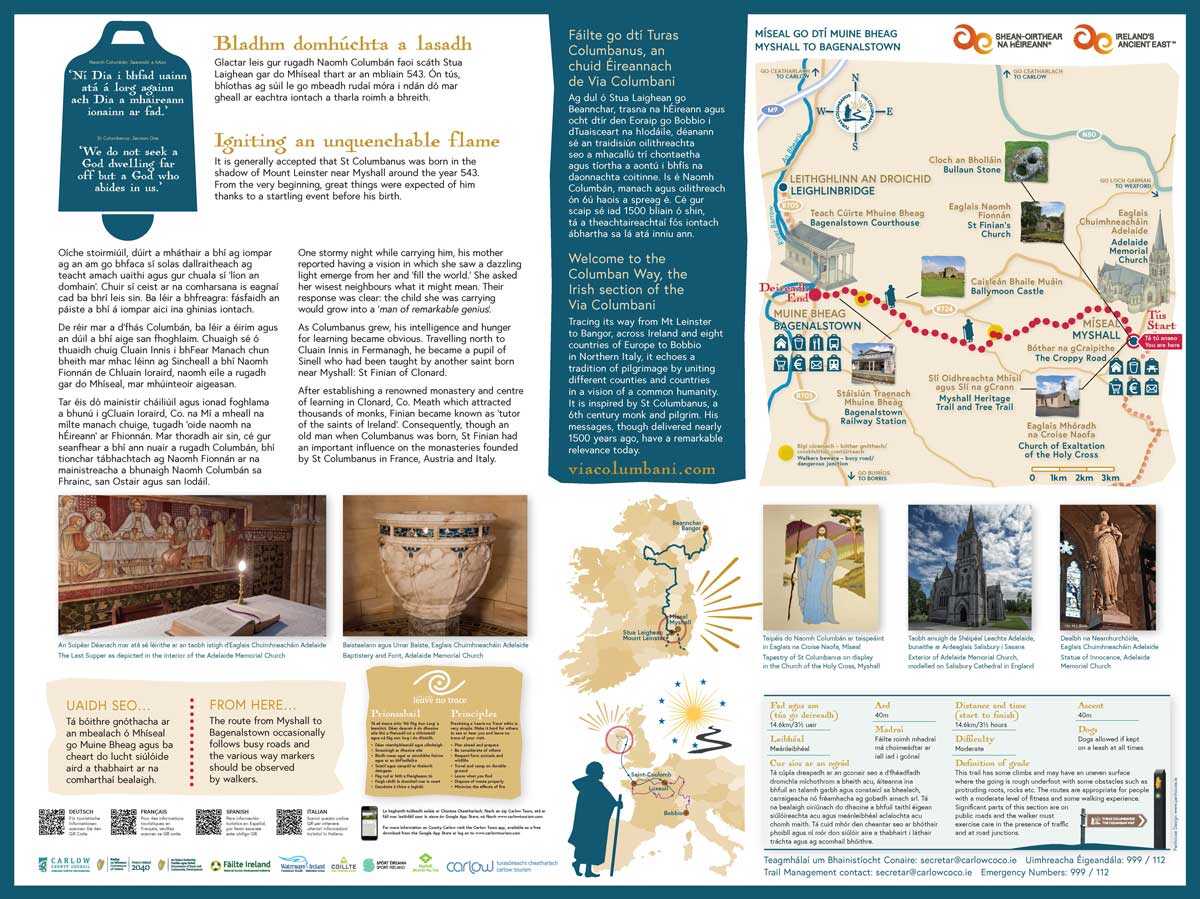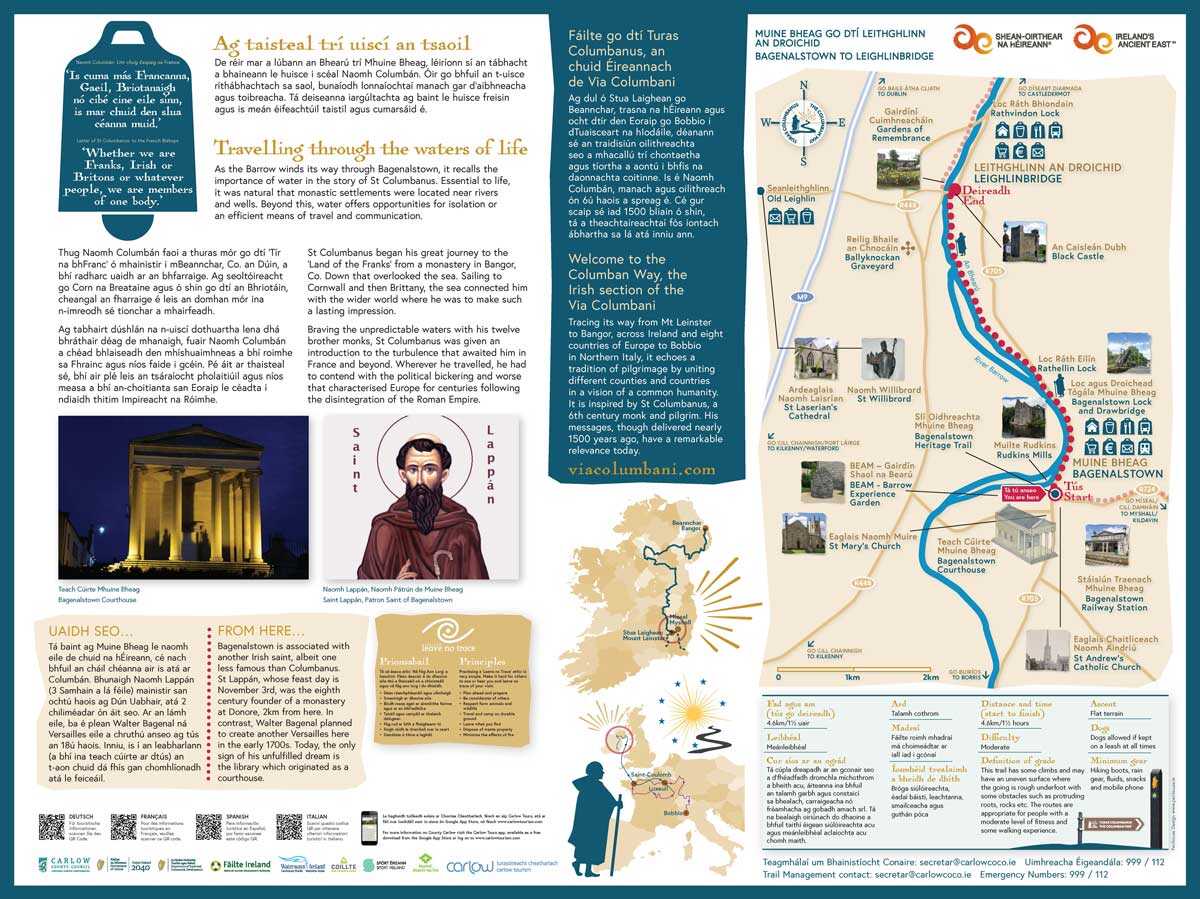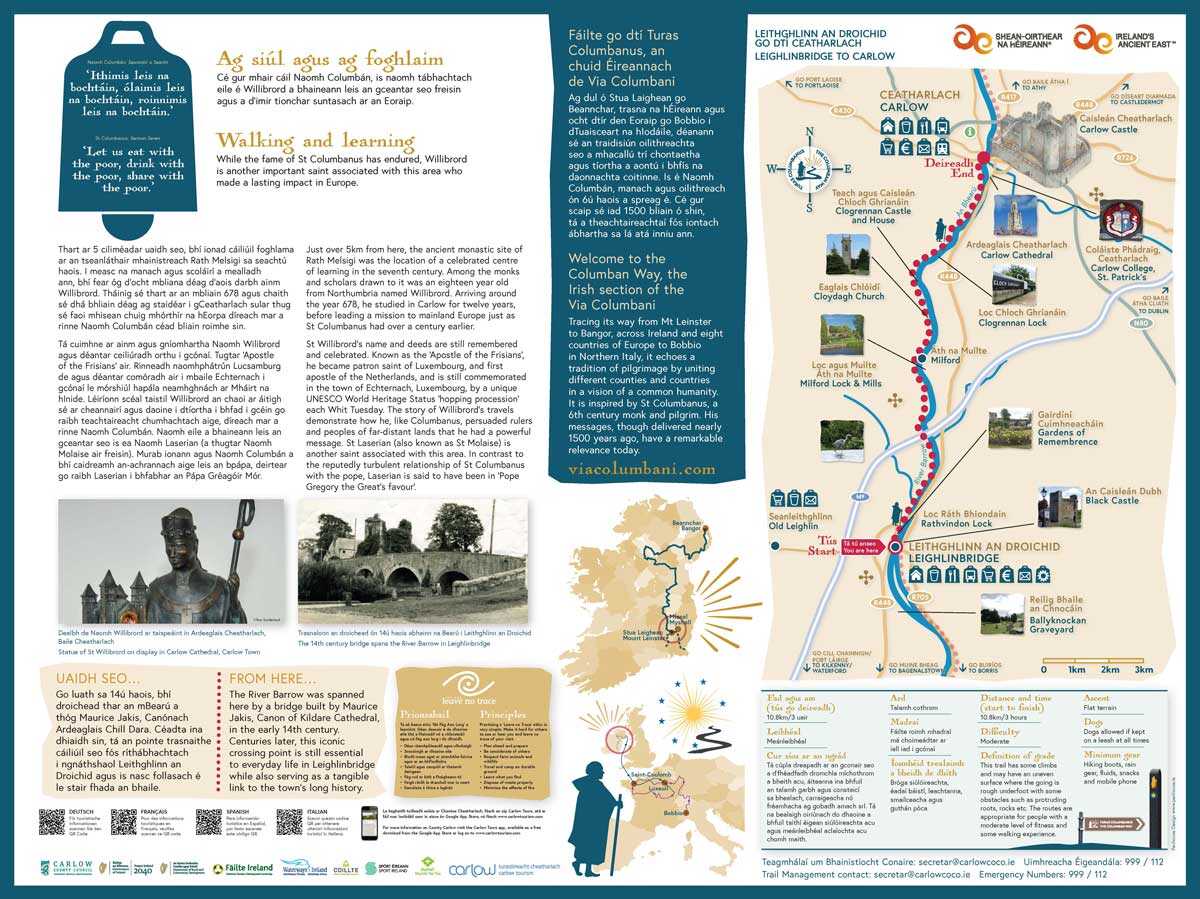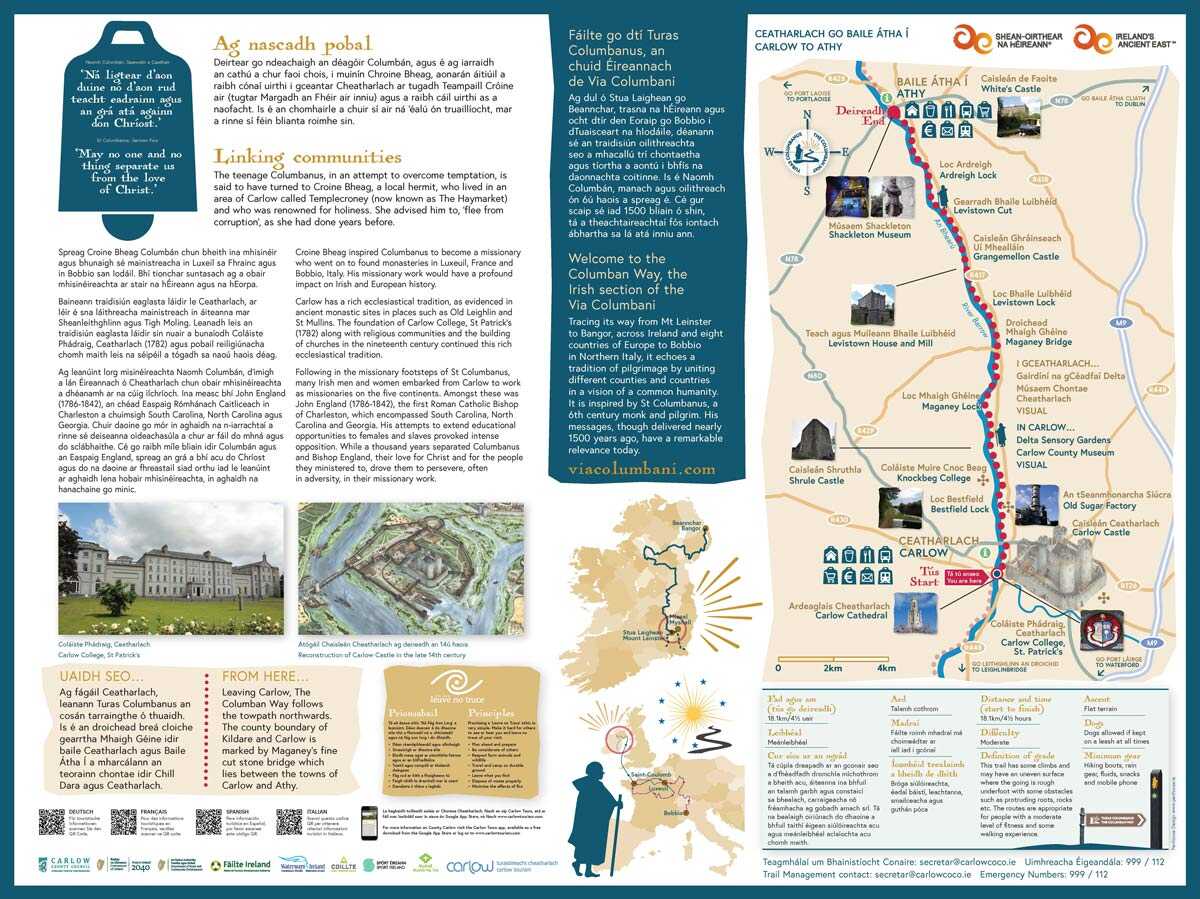The Columban Way - Carlow Tourism (original) (raw)
Welcome to the Columban Way, the Irish section of the Via Columbani.
The Columban Way walk in County Carlow gives visitors the opportunity to follow in the footsteps of the inspirational sixth century monk St Columbanus, who was born at the foot of Mount Leinster. The Carlow walk joins the finished route at Bangor, County Down as part of a wider national and European Columban Way. A journey of discovery, the walk offers visitors the opportunity to connect with nature, appreciate our rich biodiversity and enjoy their own personal journey of reflection and contemplation along the stunning landscapes of the River Barrow and the Blackstairs Mountains. It is a spiritual and pilgrim trail that connects towns and villages in County Carlow who have a deep appreciation of the lasting legacy of St Columbanus in this area, bringing together communities of different faiths and cultural traditions. Modelled on the Camino de Santiago, it features historical sites and landscapes of early Christian Ireland.
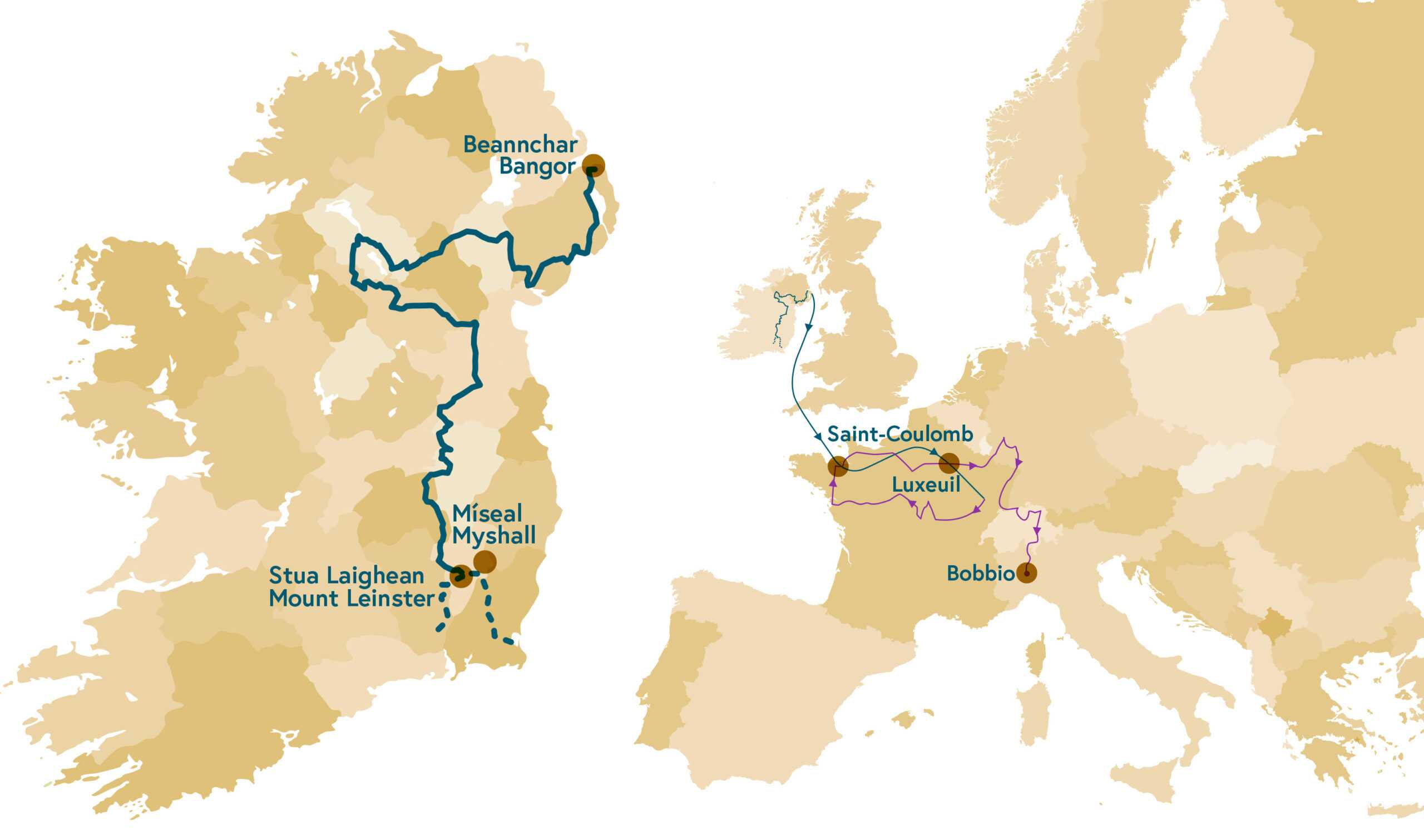
In the spirit of St Columbanus, this All-Ireland route brings together counties North and South along with eight countries across Europe to develop a 5,300km route when complete. In the meantime visitors can explore the first section of the route in County Carlow and Wexford, and the completed stage of the route in Bangor in County Down, which are fully signposted. In Carlow the route travels from the sixth century ecclesiastical site of St Mullins along the Barrow Way, and in County Wexford from the town of Bunclody to the official start of the walk at Mount Leinster, through landscapes that have remained largely unchanged for thousands of years. From there it descends into the village of Myshall before travelling along quiet country roads to reach the town of Bagenalstown. Here it rejoins the Barrow Way to Leighlinbridge and Carlow to reach County Kildare. Once fully developed, the Columban Way in Ireland will stretch for some 530km through Wexford, Carlow, Kildare, Laois, Meath, Cavan, Monaghan, Fermanagh and Down. For now the Columban Way in Carlow, from its official start point on Mount Leinster is 45km.
As you journey reflect on some of Columbanus’ sayings which, although delivered nearly 1500 years ago, continue to inspire and encourage today. You can download some of the saints most famous quotations to accompany you here
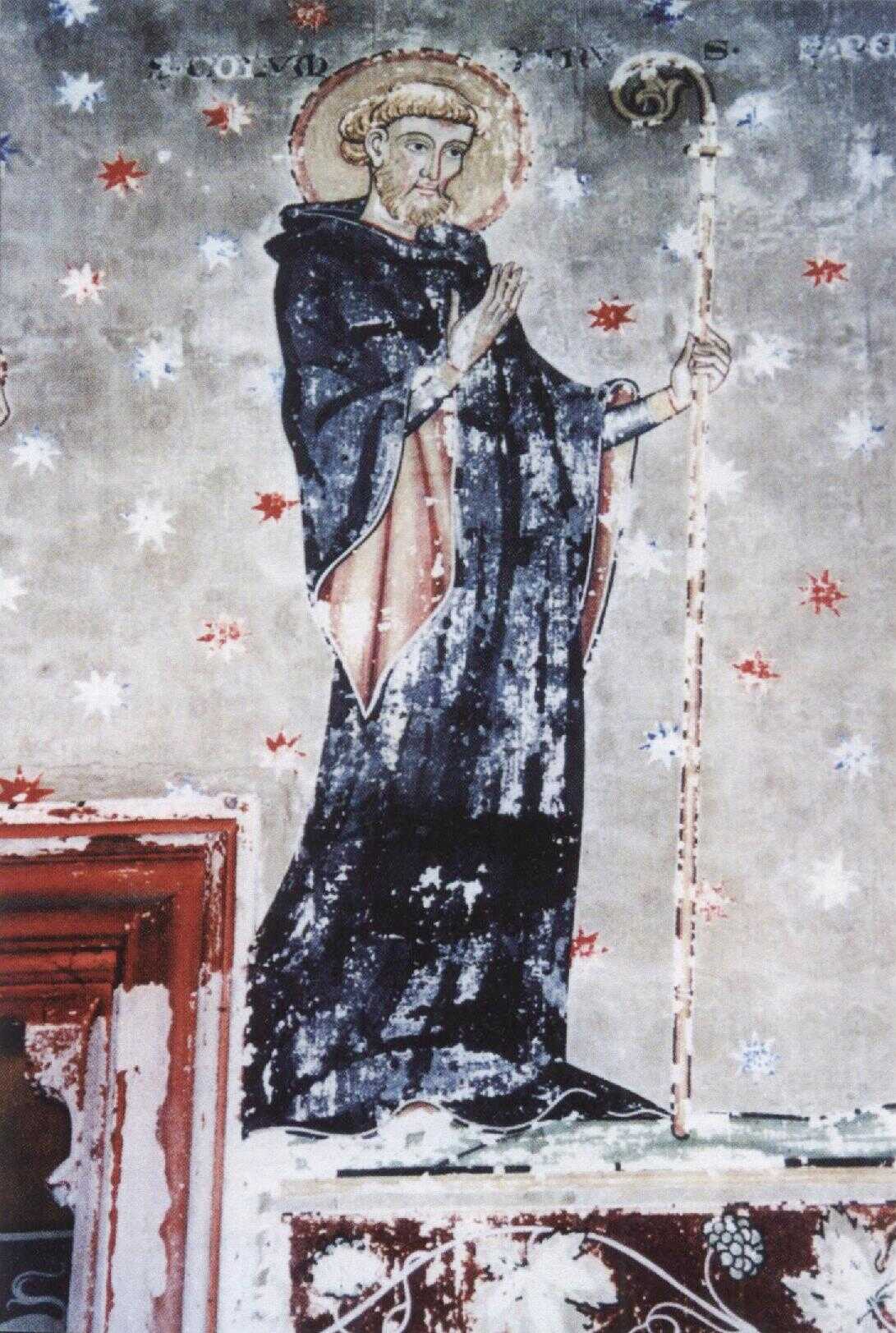 Who is St Columbanus?
Who is St Columbanus?
According to his biographer, Columbanus was born in the shadow of Mount Leinster on the Wexford/Carlow border. He became a monk in the monastery of Bangor, County Down under the Abbot St Comgall for more than 20 years before crossing the Irish Sea with twelve companions, among them St Gall from whom the city of St Gallen, Switzerland takes its name. Columbanus founded monasteries in Annegray, Fontaine-lès-Luxeuil and Luxeuil-les-Bains in the foothills of the Vosges Mountains, Eastern France; in Bregenz on the banks of Lake Constance, Austria and in Bobbio, in the region of Emilia Romagna, Northern Italy where he died. He has been described as “Ireland’s first European, a poet, scholar, abbot, preacher and teacher”.
St Mullins to Clashganny
- WHERE TO STAY ST MULLINS – CLASHGANNY
- WHERE TO EAT ST MULLINS – CLASHGANNY
- THINGS TO DO – ST MULLINS
- THINGS TO DO GRAIGUENAMANAGH
- THINGS TO DO CLASHGANNY
- EN-ROUTE FROM ST MULLINS TO GRAIGUENAMANAGH
THINGS TO DO – ST MULLINS
St Mullins Ecclesiastical site 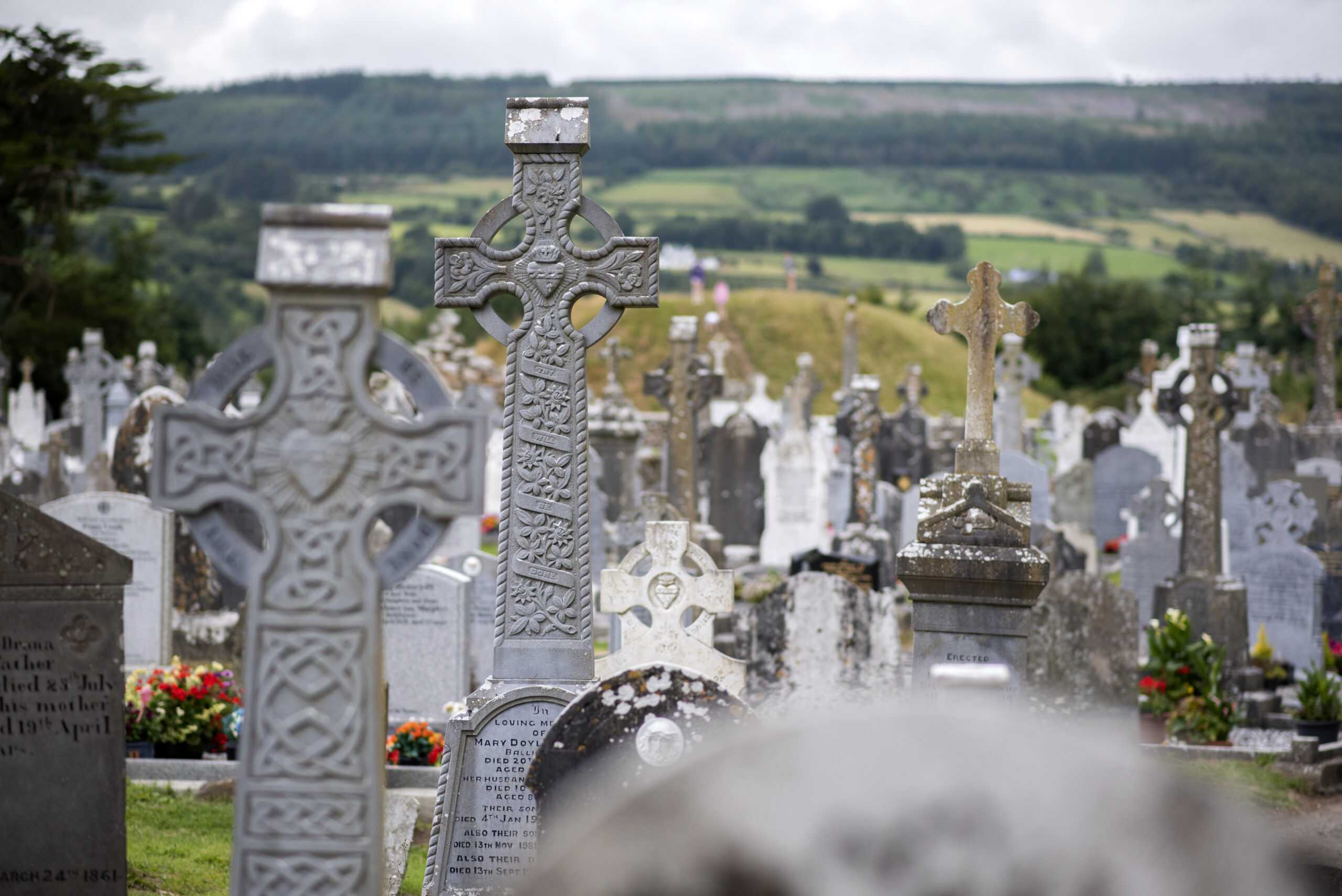
While the Columban Way walk sets off from the River Barrow on the lower settlement in St Mullins, the upper settlement is truly worth a visit in its own right. This is one of the most significant archaeological sites in Ireland’s Ancient East, standing in importance with Glendalough and Clonmacnoise and has been a place of pilgrimage since the earliest of times. The area gets its name from St Moling, born in 614 who was a prince, poet, artist and craftsman, as well as a priest. He built the monastery in St Mullins in the seventh century with the help of “Gobban Saor”, the legendary Irish builder. He was a man of self-help; he ran a cornmill for his monastery and local farmers. He dug a mile long watercourse with his own hands to power his mill – a task which took some seven years. He started the first ferry service in his home-made raft across the River Barrow. He will always be remembered and revered for obtaining the remission of the Borumean tribute, an oppressive tax levied on the people of Leinster by the High Kings of Ireland. During his lifetime many miracles were attributed to him, even to this day many cures are sought by visiting the Blessed Well. He died in 696 and is buried in St Mullins.
The monastic ruins can still be seen in the back of the graveyard and include five churches, domestic buildings and the base of a round tower. There is a ninth century granite High Cross depicting the Crucifixion and the Celtic spiral pattern.
Teampall Mór is the oldest church, parts of which may date from the tenth or eleventh century. South of Teampall Mór lie the remains of the largest church, the ‘Abbey’, which is probably fifteenth century. To the east of the ‘Abbey’ is a tiny oratory of uncertain date, dedicated to St. James. To the south are two further structures, probably post-medieval in date. The larger, a domestic building with a fireplace also has an unusual diamond shaped window in the east wall. The smaller building now functions as a mausoleum for the Kavanagh family (descendants of the Mac Murchada Kings of Leinster). Here can be seen a modest memorial to King Art Mac Murchada Caomhánach who was poisoned at New Ross in 1417.
Nowadays the graveyard and holy well is still in use by local people. The graveyard lies in the shadow of the Anglo-Norman motte and contains a fascinating collection of eighteenth and nineteenth-century gravestones. Each year on the Sunday before July 25th people gather in great numbers to celebrate mass at the Penal Altar, and remember the steadfast Catholic faith of their ancestors through difficult periods in Irish history.
Full details on the history of St Mullins can be viewed by visiting the interactive kiosk in the Pilgrim’s Park, close to the graveyard entrance or visiting HERE.
Bahana Forest Walk (close to St Mullins) 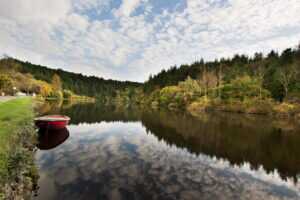
Bahana Forest takes its name from the Irish word ‘Beitheanna’, meaning a place of birch trees. This route covers a distance of 4.5km along forest tracks and the River Barrow towpath, one of the great ancient highways of Ireland’s Ancient East, offering a route inland from the Irish Sea at Waterford Harbour. From its starting point on the quayside in St Mullins, take the towpath for approximately 15 minutes, before following a canal away from the river to reach St Mullins Sea Lock – the river is tidal up to this point. Continue by the canal to reach a track junction. Turn right uphill to reach a crossroads where you turn left on the main track. Reach a three way junction and keep left to follow the forest road back down towards the river. Reach a lower track and turn sharp left to arrive back down at the towpath on the River Barrow, noting a lime kiln on your left side. Lime kilns were commonly used in the eighteenth and nineteenth centuries to burn lime stone rock in order to derive lime, which in turn was spread on the land to increase productivity. Turn left and follow the towpath back downstream with the river on your right. Soon the canal leaves the river and you follow the towpath to reach your outward route. As you walk, think of the horses that once plied this towpath pulling barges up and down the Barrow Navigation. To get a full map of the route visit HERE.
THINGS TO DO GRAIGUENAMANAGH
Duiske Abbey, Graiguenamanagh
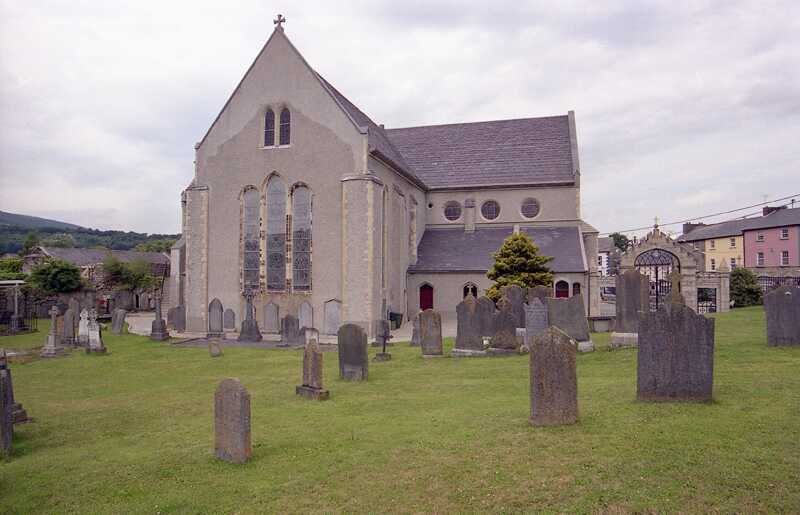
Graiguenamanagh is well known for its abbey which is a short distance up the town. One of Ireland’s finest Cistercian monasteries was founded here in 1204 by William Marshal who became Lord of Leinster following his marriage to Strongbow’s daughter Isabel. It was called Duiske Abbey from the stream that flows nearby. The church was restored in 1974-80 and consists of a nave and chancel with an aisle on each side. To truly imagine what the church must have been like when the monks lived here, take a look at the excellent model of the original monastic settlement in the interior of the church. Originally the monastery would have spread over some five acres. In the graveyard to the south of the chancel there are two small granite high crosses. These would have been important educational tools of the time, bearing stories of early biblical significance. Duiske Abbey flourished until the suppression of the monasteries in the sixteenth century. The abbey and lands were then granted to the ninth Earl of Ormond. The abbey church was allowed to decay and the abbey grounds were absorbed into the town. In 1813 a portion of the original abbey church was reroofed and further restoration was carried out laterThe abbey church was completely restored by 1980.
W: www.villageofthemonks.com/duiskeabbey
Graiguenamanagh Bike Hire, Waterside Guesthouse, Graiguenamanagh, Co. Kilkenny R95 XH3K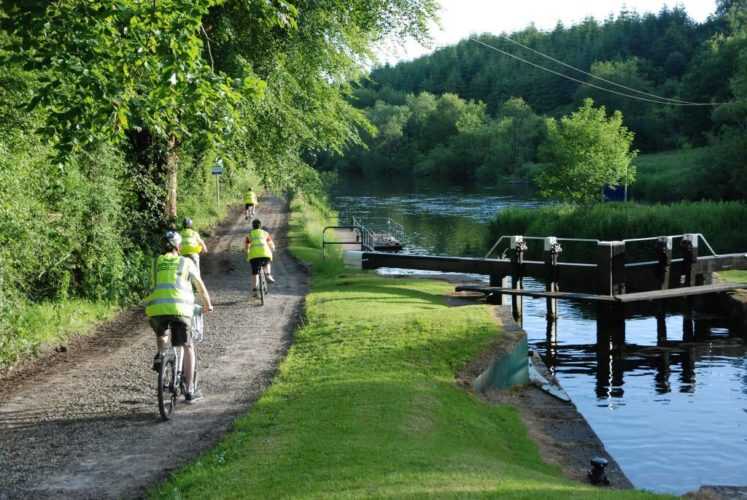
T: +353 (0) 59 9724246 / Mob: +353 (0) 86 4084008
E: bike&hike@watersideguesthouse.com
W: www.watersideguesthouse.com
Graiguenamanagh Bike Hire offers bike rental and bike tours from Graiguenamanagh and Tinnahinch in the beautiful Barrow River Valley. The longest established operator in the Barrow Valley, Graiguenamanagh Bike Hire knows the Barrow towpath better than anyone else. Perfect for groups, families or couples to explore the river towpath and discover wildlife, scenery and peace, hidden away along a traffic-free greenway. Graiguenamanagh Bike Hire basecamp is located at the famous Waterside Guesthouse which provides a cosy room with a river view as well as a superb dining experience in the ground floor restaurant. The towpath stretches for miles in either direction, drop-off and pick-up service available
Cushendale Woollen Mills, Mill Road, Graignamanagh, Co. Kilkenny R95 PP83
T: +353 (0) 59 9724118
Cushendale is one of only two remaining vertical Irish woollen mills continuing to create quality authentic textiles from the fleece of Irish sheep at their historic mill. The first mill was established on this site in 1204 by Cistercian monks, and the Cushen family trace their weaving heritage as far back as 1778. Visit their historic mill and shop to see where they design and create quality bespoke textiles and yarns from Irish wool, lambs’ wool and mohair.
Kilkenny Hydrobikes, The Rowing Club, Graiguenamanagh, Co. Kilkenny, R95 DW66
T: +353 (0)86 8954961
E: info@kilkennycyclingtours.com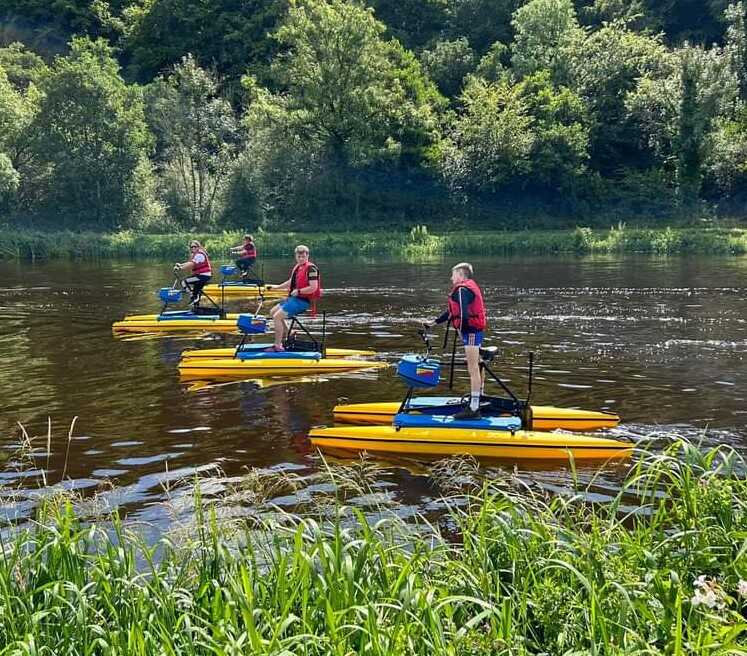
W: https://kilkennycyclingtours.com/
Hydrobikes – the most exciting new water adventure experience in Ireland to explore the River Barrow like never before! Hydrobikes provide a gentle, low-impact aerobic total body workout; but all
depends on how fast you pedal. Take a hydrobike for a leisurely ride along the River Barrow, a fast cardio workout, photography session or a spot of fishing. Environmentally friendly, easy to ride, lightweight, safe, stable, hydrobikes are the perfect way to enjoy water sports. Suitable for adventurers from ages eight upwards. Hydrobikes are single-seated, one person per bike.
Riverboat Adventures, The Quay, Graiguenamanagh, Co. Kilkenny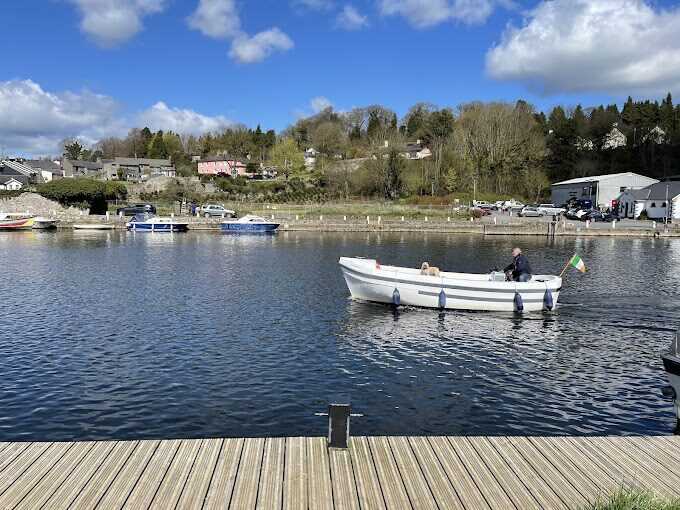
T: +353 (0) 85 2726795
E: riverboatadventures@gmail.com
Experience a charming boat tour with Riverboat Adventures along the River Barrow from Graiguenamanagh. Enjoy an open boat excursion in a 12-seater boat along this meandering, unspoilt and uncrowded waterway. Each tour lasts up to one hour and the tour operates seven days per week. Trips depart Graiguenamanagh Quay travelling to upper Tinnahinch Lock and Ballykeenan Lock. Guided tours are led by Eoin, a resident of Graiguenamanagh and brimming with knowledge about the river’s captivating history and heritage and its plant and bird life.
Hot Box Sauna, The Quay, Tinnahinch, Graiguenamanagh, Co. Carlow, R95 X635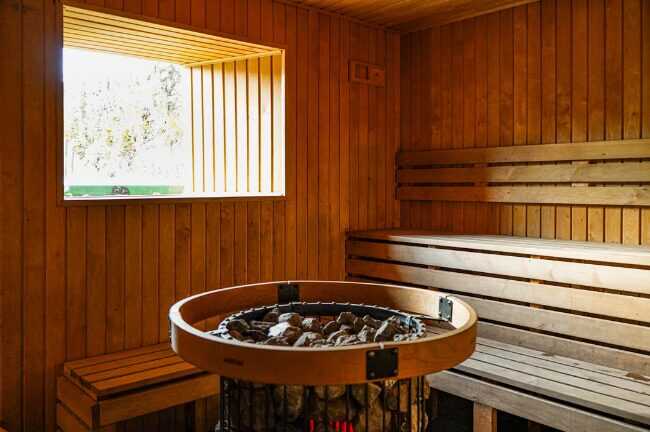
T: +353 (0)87 4743143
Immerse yourself in the wonderful experience of connecting the power of a traditional sauna with the raw beauty of an Irish river. Enjoy 45 minutes in the custom built Finnish sauna situated in a restored old stone shed overlooking the River Barrow. The Hot Box Sauna offers a unique wellness that combines traditional sauna therapy with modern comfort.
Prepare to unwind in a cosy sauna sanctuary and afterwards cool off with a refreshing plunge in the adjacent River Barrow. Whether you’re looking to relax after a long day of exploring or seeking relief from everyday stresses, this sauna is the perfect retreat.
The therapeutic benefits are numerous, including improved circulation, detoxification, stress relief and muscle relaxation. Hot Box Sauna has other convenient locations across Ireland, allowing visitors to experience their signature blend of relaxation and revitalisation wherever their travels may take them.
THINGS TO DO CLASHGANNY
Canoeing and Paddle Boarding
Clashganny is a famed spot for canoeing and paddle-boarding along the River Barrow. Take a trip with any of the two canoeing companies listed below for a fun and engaging way to experience the river. All tours are suitable for groups of friends, families and work colleagues and allow you to really appreciate the wide open spaces and unspoilt waterways of the River Barrow.
Go-With-The-Flow River Adventures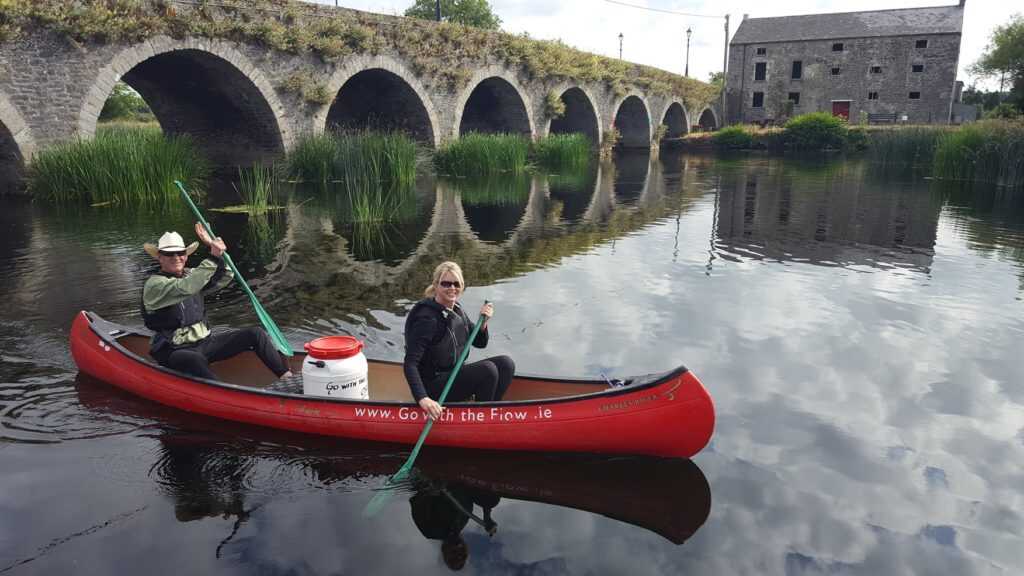
T: + 353 (0) 87 2529700
Explore the most beautiful and enchanting waterway in Ireland by canoe. Families need look no further if it’s adventure and fun you want for your great day out. Go-With-The-Flow are a favourite with those seeking spills and thrills in an action packed event. Qualified guides see you through all the whitewater, over all the weirs and waterfalls and down the rapids of the River Barrow. No experience necessary, all you need is a bunch of friends and time to chill. Tailored family learning days, corporate and social club days and individual canoe hire also available. You can spend two or three days just idling along the river, stopping off in every little village along the way. Please email for details of the popular three day canoeing camping trails. Luxurious BaseGlamp accommodation also available.
Pure Adventure – Guided Trips & Tours, The Quay, Graiguenamanagh, Co. Kilkenny, R95 DW66**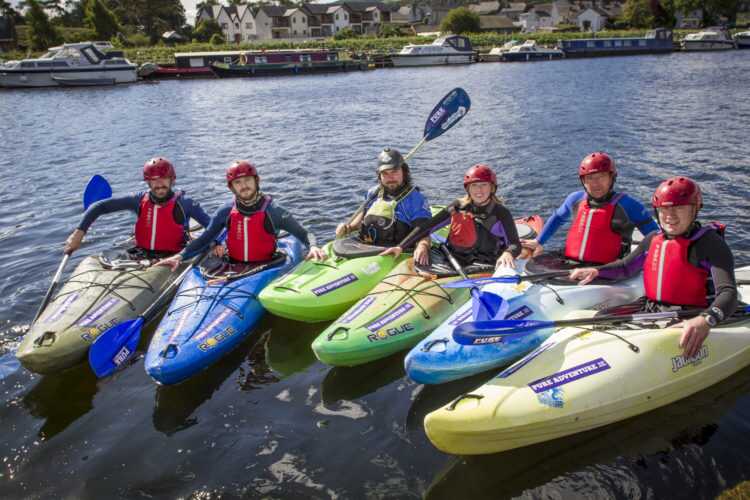 **
**
T: + 353 (0) 87 2265550
Pure Adventure is based in the heart of the Barrow Valley in the picturesque town of Graiguenamanagh. Located on the banks of the River Barrow, Pure Adventure offers a range of activities that include exhilarating white water kayaking trips, scenic canoe tours and chilled out Stand Up Paddle Board adventures along with a range of team building activities and guided walks. Pure Adventure also offers a complete range of Canoeing Ireland skills courses from beginners to advanced. All activities can be tailored to your group’s needs and desires. Full equipment is supplied, all you need to do is book in. Come join us for an adventure you will never forget. Our activities are suitable for all ages and abilities with trips and tours daily.
Clashganny Forest Trails offer the user gentle walks on forest roads and along the Barrow Way with magnificent views of Clashganny Lock and the River Barrow. Much of the walk is through an old wood which has had forestry cover present since the 1800s. The Clashganny Lock Loop is 3.5km long and takes approximately 1.5 hours to complete over flat terrain. The Clashganny Forest Looped Walk covers a distance of 6km, taking two hours to complete. To view the full walking routes click HERE.
EN-ROUTE FROM ST MULLINS TO GRAIGUENAMANAGH
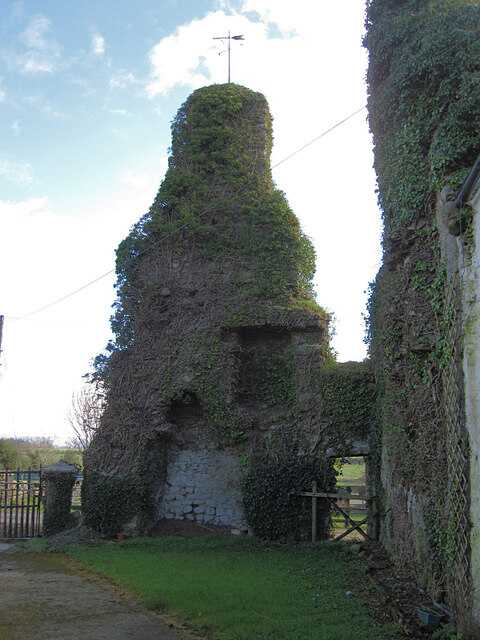 As you walk along the towpath from St Mullins northwards in the direction of Graiguenamanagh watch out for Freney’s Chair, some 500 metres below Carriglead Lock. Take a seat here and enjoy the beautiful view across the river to Brandon Hill. This seat was reputedly used by the notorious local highway man, Captain James Freney, to keep an eye on where he stashed his ill-gotten gains! Freney was a legendary figure in the area in the 17th century featuring in Thackeray’s book The Luck of Barry Lyndon and eventually became a customs officer of all things in nearby New Ross where he died in 1783.
As you walk along the towpath from St Mullins northwards in the direction of Graiguenamanagh watch out for Freney’s Chair, some 500 metres below Carriglead Lock. Take a seat here and enjoy the beautiful view across the river to Brandon Hill. This seat was reputedly used by the notorious local highway man, Captain James Freney, to keep an eye on where he stashed his ill-gotten gains! Freney was a legendary figure in the area in the 17th century featuring in Thackeray’s book The Luck of Barry Lyndon and eventually became a customs officer of all things in nearby New Ross where he died in 1783.
On the left hand side of the riverbank keep an eye out for Galmoy Castle. This was once the home of members of the Butler dynasty until it was laid waste by Oliver Cromwell’s forces.
Carriglead Lock is the oldest surviving lock in the Barrow Navigation and was built in 1763. The stonework at Carriglead is a testament to the engineers and builders who designed and made the lock. There’s lovely stonework in the beautiful renovated lock keeper’s cottage there as well. This is a most attractive stretch of the river with Brandon Hill rising steeply on the west side.
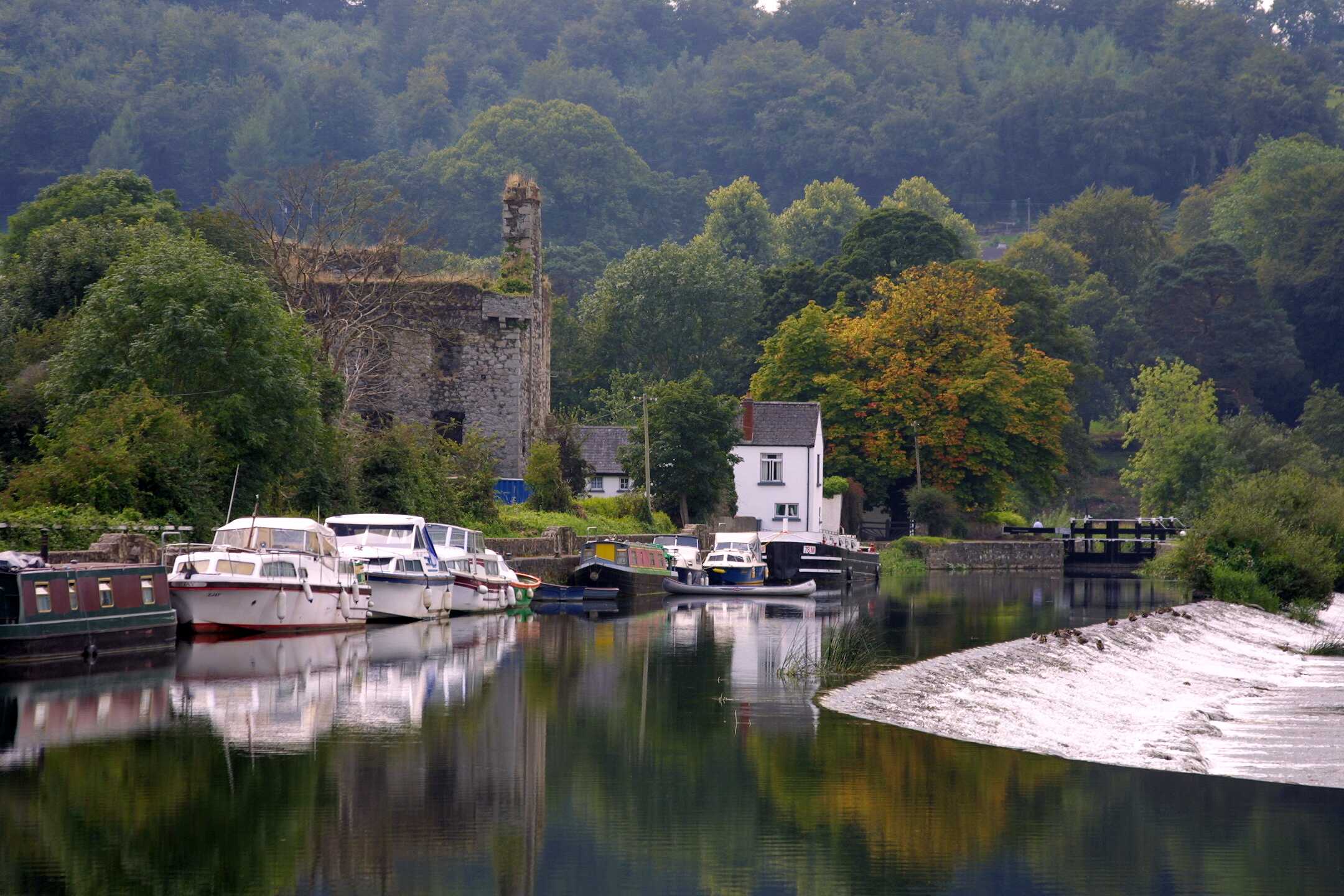
And as your near Graiguenamanagh and Tinnahinch you will notice Tinnahinch Castle, immediately beside the lock, a Butler castle built to defend the ford. In the 1540s a wooden bridge was built across the river here and the castle was an important defensive position in the prolonged struggle between the Butlers and the Kavanaghs. The castle was further strengthened in the seventeenth century and was held by the Confederates in the Cromwellian wars. Tinnahinch’s fortunes have been shaped by the River Barrow which provided employment to generations of boatmen and stimulated commerce by linking the village to the wider world – to find out more about this Carlow village visit HERE
Both Graiguenamanagh and Tinnahinch are connected by a beautiful bridge, built by George Semple in the 1767, when the canal system was being built.
Clashganny to Borris
BORRIS TO MOUNT LEINSTER AND THE NINE STONES
WHERE TO STAY
Borris Area
Blackstairs Eco Trails, The Old Rectory, Killedmond, Borris, Co.Carlow R95 N1K7
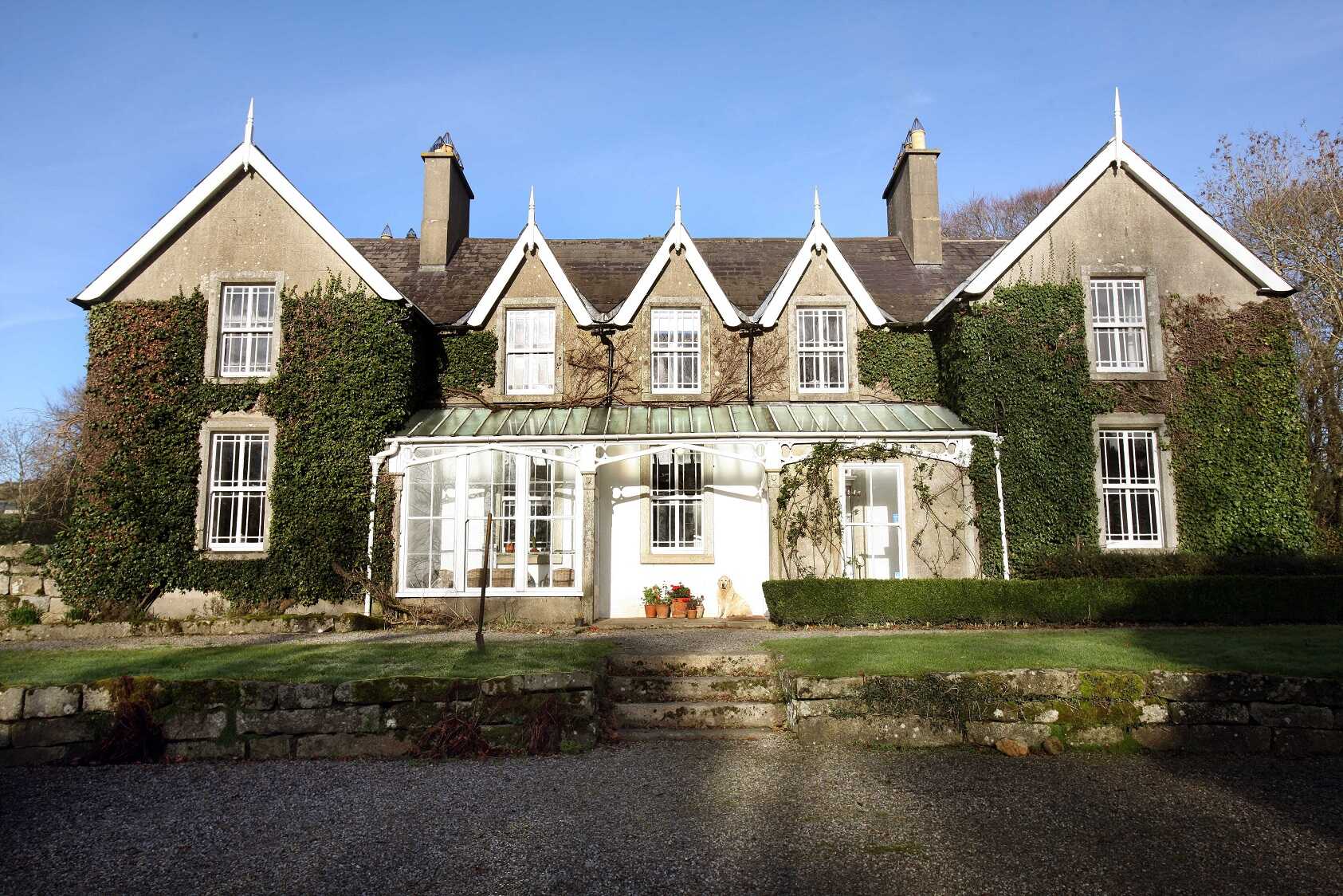
T: +353 (0) 59 9773184 / +353 (0) 87 2707189
E: info@blackstairsecotrails.ie
W**:** www.blackstairsecotrails.ie
Lorum Old Rectory, Kilgraney, Bagenalstown, Co. Carlow R21 RD45
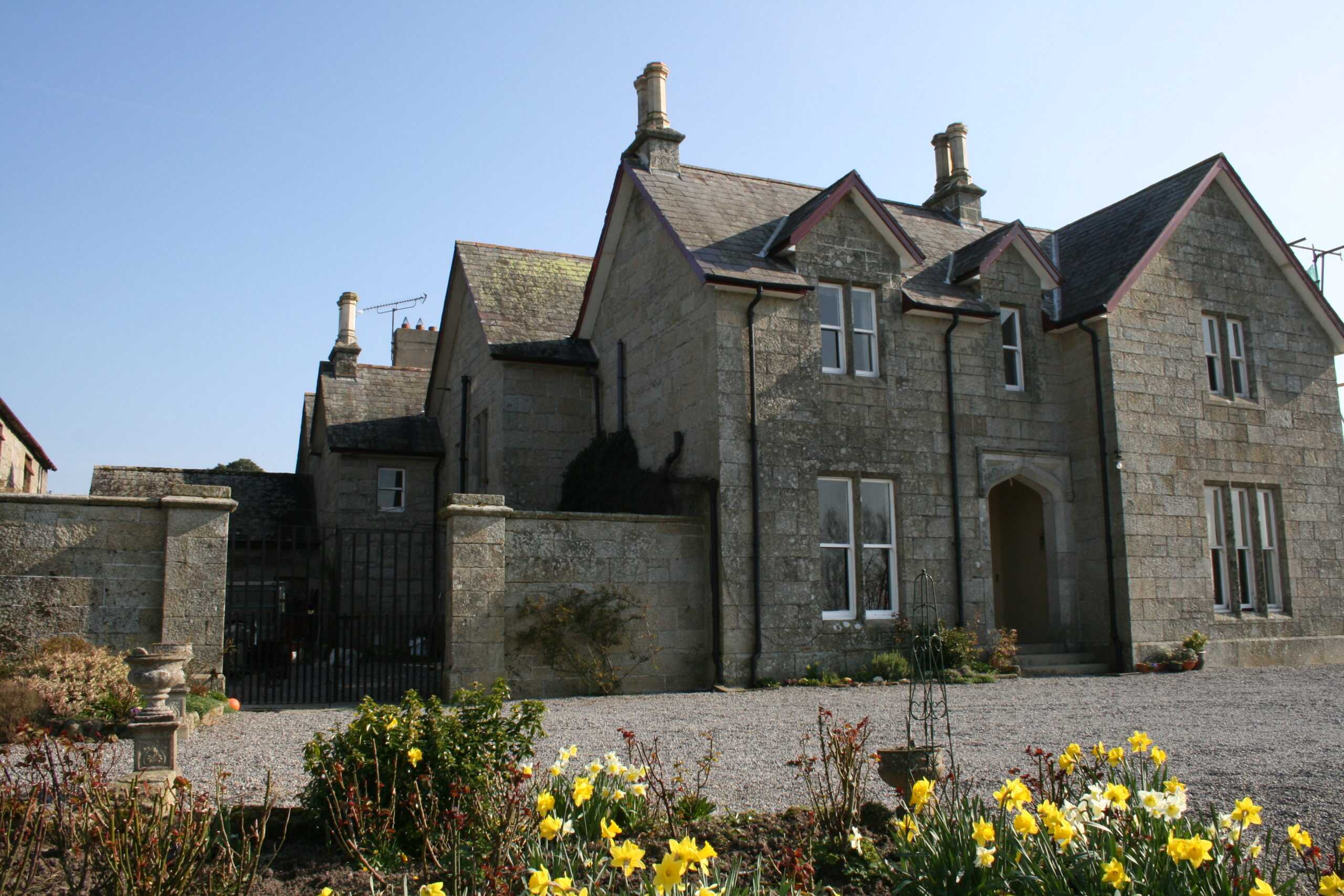
T: +353 (0) 59 9775282 / +353 (0) 86 8281644
W**:** www.lorum.com
The Step House Hotel, Main Street, Borris, Co. Carlow R95 V2CR
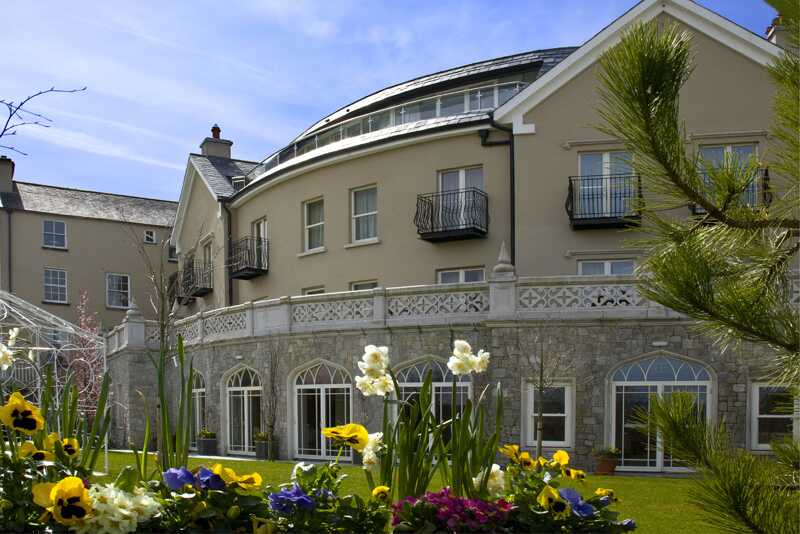
T: +353 (0) 59 9773209
BaseGlamp Accommodation, Kilcoltrim, Borris, Co. Carlow, R95 Y9Y9
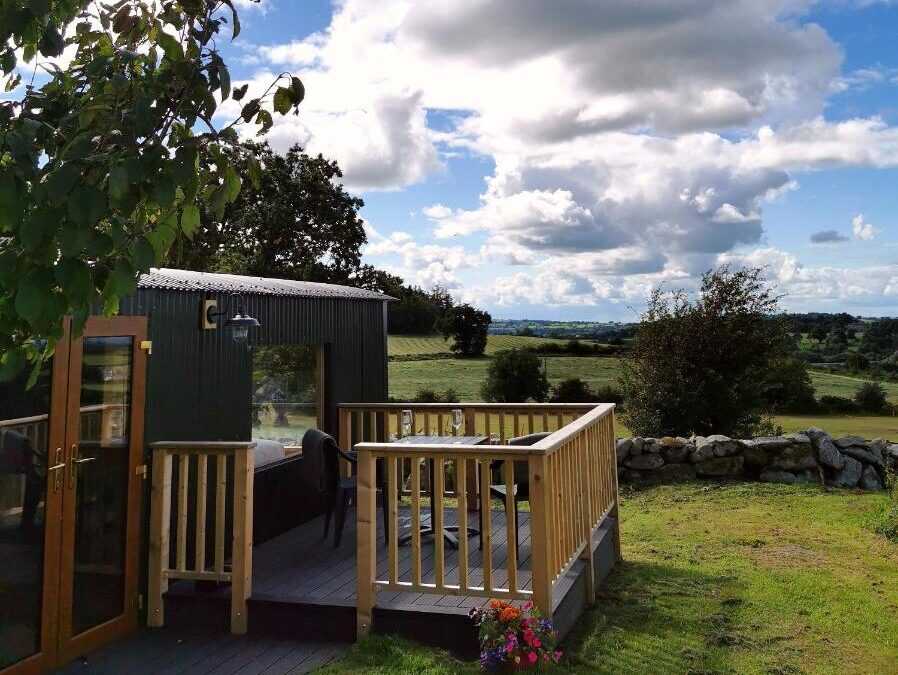 T: +353 (0)87 2529700
T: +353 (0)87 2529700
WHERE TO EAT
Borris Area
The Step House Hotel, Main Street, Borris, Co. Carlow
Dining at the Step House Hotel is a truly unforgettable experience. The exquisitely crafted menus are designed to benefit from local produce emphasising our commitment to organic foods.
Head chef Alan Foley & his team are committed to a philosophy of quality food sourcing, with an emphasis on seasonal, local and artisan ingredients. They keep the art of real cooking alive, preparing dishes from scratch with the best ingredients, to bring you real taste and real value. Supporting local producers is at the heart of the Step House where whole lambs are bought off local farmers.
Joyce’s Pub, Borris, Co. Carlow, R95 DV76
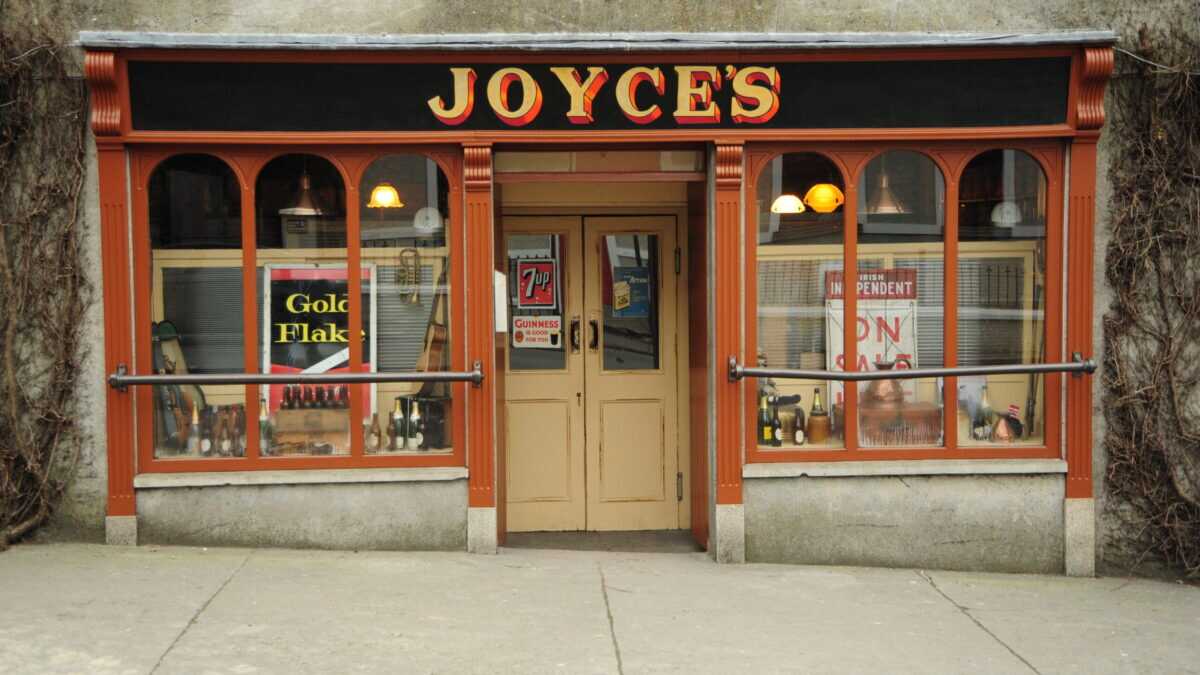
T: +353 (0) 59 9773468
This traditional pub features an old bar and grocery with a special charm of its own. Family-run and steeped in sporting tradition, visitors can expect a warm welcome and lots of lively chat. Live music some weekends. Beautiful outdoor terrace.
THINGS TO DO – BORRIS
A ribbon of quaint and elegant 19th century granite buildings, Borris stretches uphill for almost 1.5 kilometres. Adding to the village’s rich built heritage, the beautiful Church of the Sacred Heart is distinguished by its stained-glass window featuring St Brigid and local saints, Fortchern and Fiachra.
Borris House
Built in Tudor style, Borris House is one of the most impressive jewels in Ireland’s Ancient East. As the home of the Kavanagh family, direct descendants of the McMorrough Kavanagh dynasty, Borris House is of the utmost importance to Ireland’s national heritage being a uniquely Irish, rather than an Anglo-Irish house.
Surrounded by 650 acres of lush woodland and gardens, it has a secluded, otherworldly feel that transports visitors back in time and is the perfect venue for discovery and exploration. This demesne parkland landscape with serpentine avenues captures the amazing views of the surrounding countryside of Mount Leinster, the Blackstairs Mountains and Mount Brandon.
Visitors on the house tour can expect lavish ceilings with ornate plasterwork, original furniture, porcelain and paintings. Discover hidden gems such as the Chapel of St Moling and learn all about the not-for-profit lace industry run by the house during the famine, and the family themselves.
In the recently restored Granary, visitors can watch a film on the history of the McMorrough Kavanaghs, ancient kings of Leinster and Borris House, walk around the Lace Garden and visit the restored Victorian laundry.
Stroll along the woodland paths, enjoy some of the beautiful specimen trees, view the original Stew Pond and 18th century Ice House. The Store at Borris House sells local crafts, jewellery, ceramics, leather goods and textiles and is located at the front gate entrance.
Check the website for precise opening times for Borris House and the Store House. Tea, coffee and light snacks available
Borris House, Borris, Co. Carlow R95 W983
T: +353 (0) 59 9771884
Borris Viaduct Walk
The sixteen arched Borris Viaduct spans the Mountain River valley at the southern end of Borris Town and is one of the most impressive examples of industrial heritage in Ireland’s Ancient East. It was commissioned by Arthur McMorrough Kavanagh of nearby Borris House, for the purpose of extending the railway to Palace East in Wexford. It opened in 1860, having cost £20,000, and taken two years to build. The building of the viaduct attracted labourers from local areas, as well as from as far afield as Dublin. The Hughes brothers walked every day, to and from work on the viaduct to their home near Ballon, County Carlow, a round trip of some thirty miles.
Construction was an enormous task and included engineers, stone cleavers who split the stone along natural fault lines, stone cutters who cut and dressed the stone ready for use, carters who transported the stone to site and labourers.
A most remarkable fact is that the work was completed using only a steam crane and almost no other machinery. The arches reach an average height of 40 feet. The last train to use the line was a special train provided for Borris Fair on March 25th 1963. Today the viaduct has undergone an extensive regeneration programme which has transformed the previous inaccessible track-way into a delightful public walk with a picnic area and tables.
Eco-Trail/Foraging workshop and Celtic Tree Trail
Want to know more about the birds, flora, fungi, mammals, and butterflies of the Blackstairs Mountains and the River Barrow? Blackstairs Eco Trails can lead you on a relaxing eco walk – low hills to no hills – and offer guided hikes, wild mushroom events, stargazing and more. A bespoke Celtic Tree Trail with accompanying 16-minute film, introduces guests to the wonders of Ireland’s native trees.
Blackstairs Eco Trails, The Old Rectory, Killedmond, Borris, Co Carlow R95 N1K7
T: +353 (0) 59 9773184 / +353 (0) 87 2707189
E: info@blackstairsecotrails.ie
W: www.blackstairsecotrails.ie
Golf
Established in 1907, Borris Golf Club is one of the oldest clubs in Ireland and this is reflected in its mature parkland course. The breath-taking scenery of the surrounding countryside combined with the strategic design of the course, ensure that all who visit, always return! Spectacular views of Borris House, Mount Leinster and the famous Borris Viaduct can be enjoyed from the course.
TYPE OF COURSE: 9 hole parkland – 6,221 yards (5,689 metres) – Par 70. SSS 69.
OPENING TIMES: Daylight hours, year-round. The clubhouse bar is open from 12pm – 9.30pm each day (restricted hours during winter months). Light meals served. HIRE SERVICES: Caddy car and buggy hire.
Borris Golf Club, Deerpark, Borris, Co. Carlow R95 ET21
T: (+353) 059 9773310
Soap-making workshops
Cold process soap-making is a therapeutic and fun craft. You will get to make your very own batch of soap learning all the tips and secrets along the way. This workshop is suitable for beginners or the “just getting started” soap maker.
The Soap Workshop, Kilcoltrim, Borris, Co. Carlow
T: +353 (0) 87 7931101 E: thesoapworkshopireland@gmail.com
EN ROUTE FROM BORRIS TO THE NINE STONES
From Borris, The Columban Way follows quiet roads before ascending steadily to the Nine Stones Viewing Point. There, a breath-taking vista of County Carlow’s beautiful countryside can be experienced.
The Nine Stones Viewing Point provides an unrivalled vista of the rich and colourful Carlow countryside spread out like a tapestry before you. Eight counties can be viewed from this spot – Carlow, Laois, Kildare, Wicklow, Wexford, Waterford, Kilkenny and the mountains of Tipperary, and on a clear day the coast of Wales, to the east. On the lower side of the road, you will see an alignment of nine small stones
Rathanna to MOUNT LEINSTER AND THE NINE STONES
EN-ROUTE FROM RATHANNA – NINE STONES
In the centre of the village is St Fortchern’s Church, Rathanna which dates to 1885. Early gothic in style, it’s architect was William Hague. The church is named after St Fortchern who founded the nearby monastery of Killoughternane
The Columban Way departs from this hillside village, overlooked by the Blackstairs Mountains, before following tranquil country roads. As you ascend to the Nine Stones Viewing Point, you can enjoy wonderful countryside and views.
MOUNT LEINSTER AND THE NINE STONES to Myshall
WHERE TO EAT- MYSHALL
Roberts of Myshall, Myshall, Co. Carlow 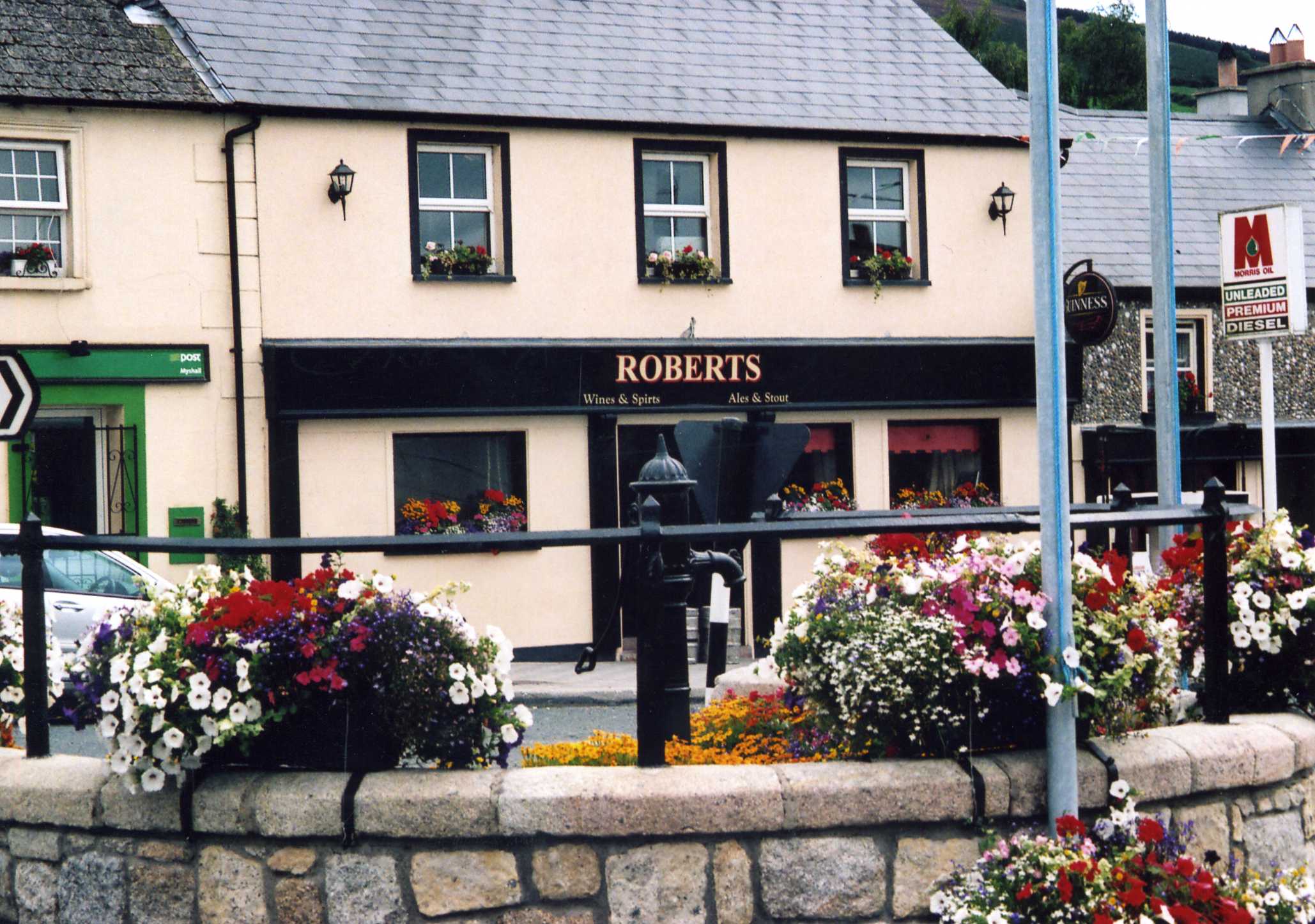
T: + 353 (0) 59 91 57612
Set in the heart of the pretty village of Myshall, this family run, traditional establishment offers the tourist a warm, hospitable welcome. Cosy open fire and comfortable surroundings. Light lunch/snacks, tea/coffee available. Live entertainment most weekends – ceol, craic agus caint.
THINGS TO DO – NINE STONES
Mystery surrounds the origin of the stones that give this location its name. One legend says they commemorate nine shepherds lost in a long-forgotten storm. Others describe them as memorials to dead chieftains or even 1798 rebels.
Nearby locations are also shrouded in myth. These include Croaghaun, the hill 4km north-east of the Nine Stones which was the reputed home of St Finian (b. 454). Finian established the renowned monastery at Clonard, Co Meath and was known as ‘tutor of the saints of Ireland. Another nearby feature explained by folklore are the ‘Cailín Slipes’, (‘Witch’s Slide’), a 300 metre ‘track’ bounded by two parallel ridges, leading down to the road. This was said to have been made by a massive witch who stumbled and slid down the hillside after lobbing a boulder towards an enemy.
Whatever the truth of these stories, this spot is a magnificent vantage point from which to see up to eight counties – and even as far as Wales – on a clear day.
The Columban Way Cairn situated at the Nine Stones is a fitting celebration of St Columbanus, who was born here in the shadow of the Blackstairs Mountains. And it was from here that he set off to found the famous monastery at Bangor, and subsequently many other settlements throughout Europe.”
This spot therefore holds a very special place in the history of Columbanus and the development of the Columban Way here in Ireland. It would be hard to find a more stunning view and it is interesting that this vista must surely have stayed long in the mind of Columbanus as he founded some of his most well-known monasteries across Europe in very similar landscapes including those in Annagrey and Luxeuil.
THINGS TO DO – MYSHALL AREA
Myshall’s name derives from the Irish ‘Maigh Íseal’ meaning ‘Low Plain’. While the village’s tranquillity and charm is obvious, exploring the Myshall Heritage Trail will reveal the ancient myths, dramatic stories and inspirational personalities that help give Myshall its unique character. Departing from the Community Centre, the heritage trail features some twenty attractions and stories associated with this special village.
Myshall Tree Trail starts adjacent to Myshall Community Centre from where one can see two monkey puzzle trees and a high cross. While there are numerous trees along the trail, twenty-five notable species have been chosen which are a mix of both native and non-native.
Echoes across Europe
Born near here around the year 543, St Columbanus spent many years in the great monastery of Bangor, Co Down before setting out for the European mainland. There, he clashed with bishops and kings, gathered countless followers and – 1500 years after his death – inspired a founding father of the European Union. But even before Columbanus made his mark, another remarkable churchman was born in Rossacurra less than 2km southwest of the village.
Saint Finnian, known as the ‘tutor of the saints of Ireland’, is believed to have founded four local churches including one in Myshall itself. However, his greatest achievement was establishing a renowned European centre of learning at Clonard, Co Meath.
Adelaide Memorial Church
In 1887, Myshall Lodge’s heir Inglis Cornwall-Brady (1859-1896) became engaged to Constance Duguid who had travelled from England to visit her sister. But before they could marry Constance was killed by a fall while hunting. Initially, her distraught parents commemorated Constance by erecting a marble statue depicting ‘Innocence’. But following his wife’s death, John Duguid commissioned George Coppinger Ashlin, one of Ireland’s foremost architects to build the church. A miniature copy of Salisbury Cathedral, the church is a stunning memorial to a beloved daughter and wife.
Adelaide Memorial Church of Christ the Redeemer, Myshall, Co. Carlow
T: +353 (0) 59 9157671 (Ms. Bridie Daly, key holder)
T: +353 (0) 59 9157584 / +353 (0) 87-9293661 (Mr. John Kelly, tour guide)
Myshall to Bagenalstown
WHERE TO EAT
Roberts of Myshall, Myshall, Co. Carlow
T: + 353 (0) 59 91 57612
Set in the heart of the pretty village of Myshall, this family run, traditional establishment offers the tourist a warm, hospitable welcome. Cosy open fire and comfortable surroundings. Light lunch/snacks, tea/coffee available. Live entertainment most weekends – ceol, craic agus caint.
The Railway House Bar and Restaurant, Church Street, Bagenalstown, Co. Carlow, R21 W688
T: + 353 (0) 59 972 0676
E: markdoyle.railway@yahoo.com
THINGS TO DO – MYSHALL
Myshall’s name derives from the Irish ‘Maigh Íseal’ meaning ‘Low Plain’. While the village’s tranquillity and charm is obvious, exploring the Myshall Heritage Trail will reveal the ancient myths, dramatic stories and inspirational personalities that help give Myshall its unique character. Departing from the Community Centre, the heritage trail features some twenty attractions and stories associated with this special village.
Myshall Tree Trail starts adjacent to Myshall Community Centre from where one can see two monkey puzzle trees and a high cross. While there are numerous trees along the trail, twenty-five notable species have been chosen which are a mix of both native and non-native.
Echoes across Europe
Born near here around the year 543, St Columbanus spent many years in the great monastery of Bangor, Co Down before setting out for the European mainland. There, he clashed with bishops and kings, gathered countless followers and – 1500 years after his death – inspired a founding father of the European Union. But even before Columbanus made his mark, another remarkable churchman was born in Rossacurra less than 2km southwest of the village.
Saint Finnian, known as the ‘tutor of the saints of Ireland’, is believed to have founded four local churches including one in Myshall itself. However, his greatest achievement was establishing a renowned European centre of learning at Clonard, Co Meath.
Adelaide Memorial Church
In 1887, Myshall Lodge’s heir Inglis Cornwall-Brady (1859-1896) became engaged to Constance Duguid who had travelled from England to visit her sister. But before they could marry Constance was killed by a fall while hunting. Initially, her distraught parents commemorated Constance by erecting a marble statue depicting ‘Innocence’. But following his wife’s death, John Duguid commissioned George Coppinger Ashlin, one of Ireland’s foremost architects to build the church. A miniature copy of Salisbury Cathedral, the church is a stunning memorial to a beloved daughter and wife.
Adelaide Memorial Church of Christ the Redeemer, Myshall, Co. Carlow
T: +353 (0) 59 9157671 (Ms. Bridie Daly, key holder)
T: +353 (0) 59 9157584 / +353 (0) 87-9293661 (Mr. John Kelly, tour guide)
THINGS TO DO – BAGENALSTOWN
Bagenalstown Heritage Trail. Here you will discover the fascinating stories associated with this market town nestled in the lush green landscape of Ireland’s Ancient East.
The foundations of Bagenalstown in the early 18th century are shrouded in myth and legend. It is often said that local landowner, Walter Bagenal wanted to develop the town along the lines of the grand city of Versailles in northern France. Certainly, Bagenalstown is unusual in Ireland for its wide streets and its structured grid pattern and although the town may not have become an opulent aristocratic centre like Versailles, Bagenal did manage to establish a thriving trading hub on his estate.
Bagenalstown went on to become an affluent town with a rich tradition of milling throughout the 18th and 19th centuries. This success was due, in no small part, to the town’s strategic location along the banks of the River Barrow. During the 19th century, the canal was developed and this provided increased access to the country’s main cities through a network of inland waterways.
Many of the buildings associated with that wonderful industrial heritage can be found along this heritage trail. Fine public buildings, such as the classically-styled train station and courthouse, are products of the town’s prosperity during the 19th century. Its rich Christian heritage can be seen in the town’s two beautiful gothic revival churches. To access the full trail visit here.
Bagenalstown Railway Station
The opening of its railway station at the end of the 1840s helped to revive Bagenalstown’s fortunes. Despite the station being an architectural gem, a debate surrounds the identity of its designer. William Deane Butler (c.1794-1857) designed Dublin’s Connolly Station while English architect Sancton Wood (1818-1887) was responsible for Heuston Station. Either man may have designed Bagenalstown station and it is a testament to
its architect that the station has remained largely unaltered since it opened.
By the Barrow
Also unchanged since Victorian times is the River Barrow. Bagenalstown is located on a beautiful bend in the river along which grain, beet, coal and turf plus many other goods were transported during the 19th century. Among the mills built along the river was Rudkins Mill owned by William Rudkin of Wells, Bagenalstown. Rudkin settled in New York in 1855 and his granddaughter-in-law Margaret Rudkin (1897-1967) developed one of America’s best-known bakery brands in the 1930s. Driven by her son’s severe allergies, Margaret created a preservative-free bread she named after the family’s home: ‘Pepperidge Farm’.
Bagenalstown’s many mills depended on the river for transporting essential goods and materials. Today, Bagenalstown has a wonderful legacy of industrial architecture which, along with riverside walks, picnic tables and a picturesque lock, make it somewhere that’s always worth taking time out to visit.
Boat Trips
If you want to relax and enjoy the fantastic scenery along the River Barrow surrounded by the history that makes Bagenalstown so beautiful, there is no better way to do it than with a trip onboard An Bád Keppel. The journey of a lifetime along the man-made canal in Bagenalstown awaits visitors who will experience the story of how it all happened, and enjoy the beauty of the wildlife. It is a journey you don’t want to miss and will never forget. An Bád Keppel is operated as a community boat trip by a group of enthusiastic volunteers who are keen to share their knowledge of the beautiful River Barrow.
An Bád Keppel, Bagenalstown Trip Boat, Bagenalstown Quay, Dunleckny, Co. Carlow
M: + 353 (0) 89 974 8127
E: bookings@bagenalstowntripboat.com
W: bagenalstowntripboat.com
Gardens
The Barrow Experience is a unique series of ten interconnecting gardens which bring to life the history, folklore and heritage of the beautiful Barrow Valley. It is situated in the grounds of BEAM Services, a training centre for people with intellectual disabilities, on a picturesque site that bounds the canal off the River Barrow. There are ten individual gardens within the Barrow Experience – Dinn Righ, Druids’ Wood, Potager Garden, Monastic Courtyard, Convent Garden, Reflective Garden, Water Garden, Co-operation Garden, Mindfulness Garden and the French Garden. The gardens represent both an active, healthy environment for our members to work in, and a therapeutic environment to relax in – along with the general public, who are always welcome.
BEAM – The Barrow Experience Garden, Barrow Lane, Regent Street, Bagenalstown, Co. Carlow R21 AH73
T: + 353 (0) 87 122 3453 (John Murphy)
Pitch & Putt
This club was established in 1963 and is set over five picturesque acres allowing plenty of room for the odd stray shot! The course comprises 18 holes with various lengths and elevations from 32m to 70m which provide a challenge to even the most experienced players. New members are always welcome.
TYPE OF COURSE: Championship Standard 18 Hole Par 3 Pitch and Putt.
OPENING TIMES: Daylight hours all year round. MEMBERSHIP: Adult single €80, family €100, student €50 HIRE SERVICES: Clubs available by prior arrangement only
Bagenalstown Pitch & Putt, McGrath Park Sports Complex, Dunleckney, Bagenalstown, Co. Carlow, R21 FX60
M: + 353 (0) 86 153 0420 / + 353 (0) 86 7812 711
Swimming
Bagenalstown Swimming Club is a long-established voluntary club located in idyllic surroundings adjacent to the River Barrow. An ideal destination for all age groups to enjoy swimming activities in geo-thermally heated pools. A paddling pool offers younger swimmers the chance to get confident with water, the 25m pool allows all swimmers to progress and enjoy swimming in a relaxed, outdoor environment. The club also offers swimming lessons, summer camps, water safety classes, river races and swimming galas. Seasonal membership and casual rates available. All are welcome.
Bagenalstown Outdoor Swimming Pool, Leighlinbridge Road, Bagenalstown, Co. Carlow R21 RR72
E: bagenalstownswimmingpool@gmail.com
W: https://www.facebook.com/BagenalstownSwimmingPool
OPENING TIMES: Early June – Late August 11am – 12.30pm, 2
Bagenalstown to Leighlinbridge
WHERE TO STAY
Lorum Old Rectory, Kilgraney, Bagenalstown, Co. Carlow R21 RD45 
T: +353 (0) 59 9775282 / +353 (0) 86 8281644
Matty’s Pub & Accommodation, Royal Oak Village, Bagenalstown, Co. Carlow
R21 K883
T: +353 (0) 87 2536025
The Lord Bagenal Inn, Main Street, Leighlinbridge, Co. Carlow R93 E189 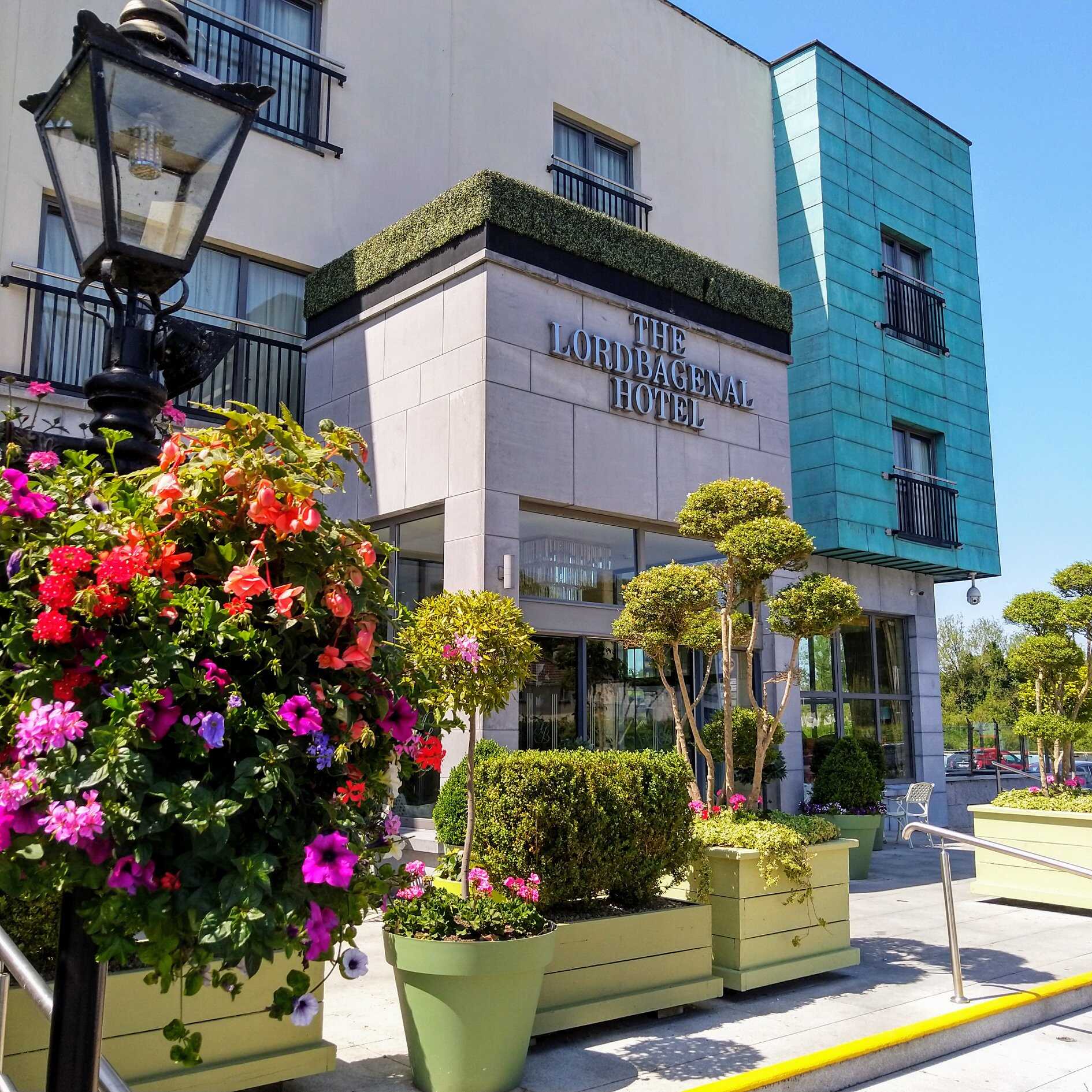
T: +353 (0) 059 9774000
The Mews Self-Catering, Leighlinbridge, Co. Carlow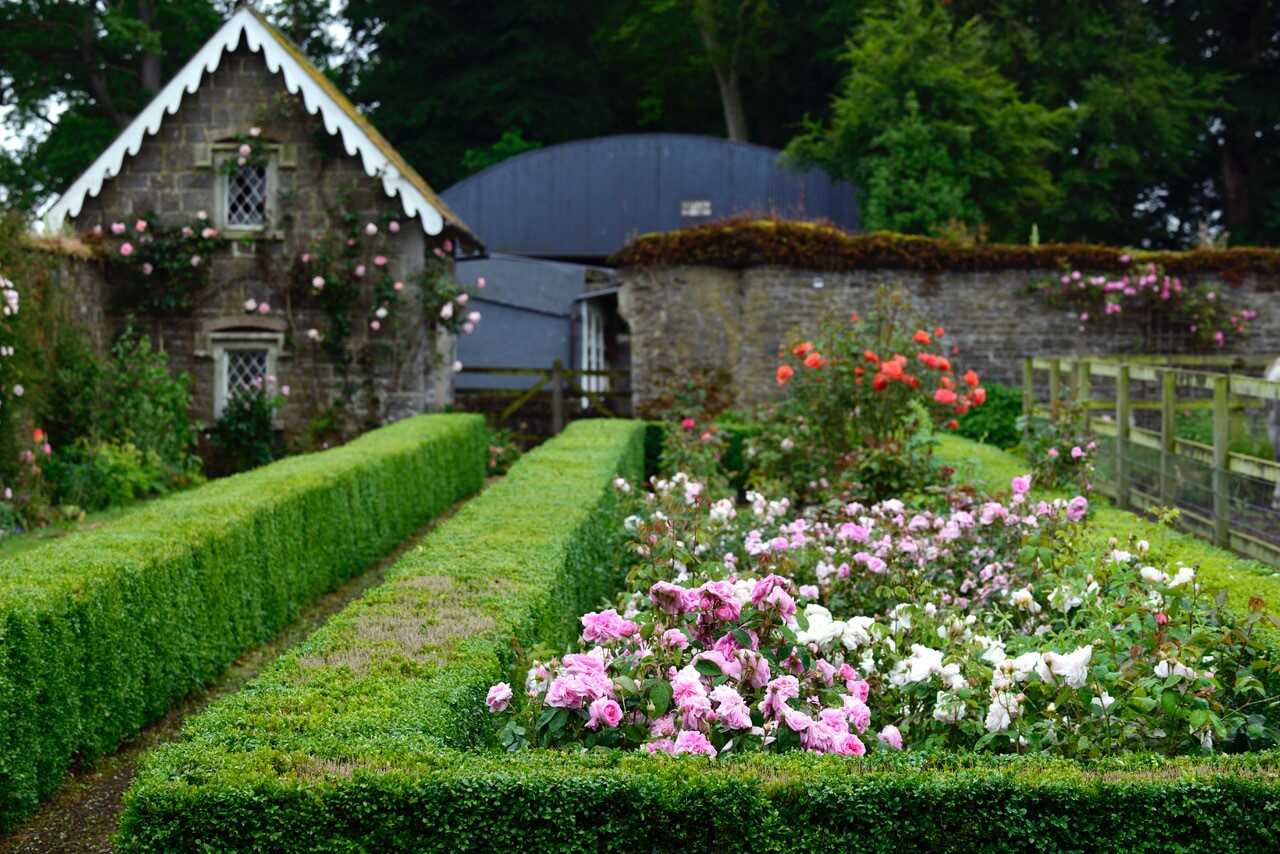
T: +353 (0) 87 2618418
WHERE TO EAT
The Railway House Bar and Restaurant, Church Street, Bagenalstown, Co. Carlow, R21 W688
T: + 353 (0) 59 972 0676
E: markdoyle.railway@yahoo.com
The Lord Bagenal Inn, Main Street, Leighlinbridge, Co. Carlow R93 E189 
T: +353 (0) 059 9774000
Rachel’s Garden Café, Arboretum Home & Garden Heaven,
Old Kilkenny Road, Leighlinbridge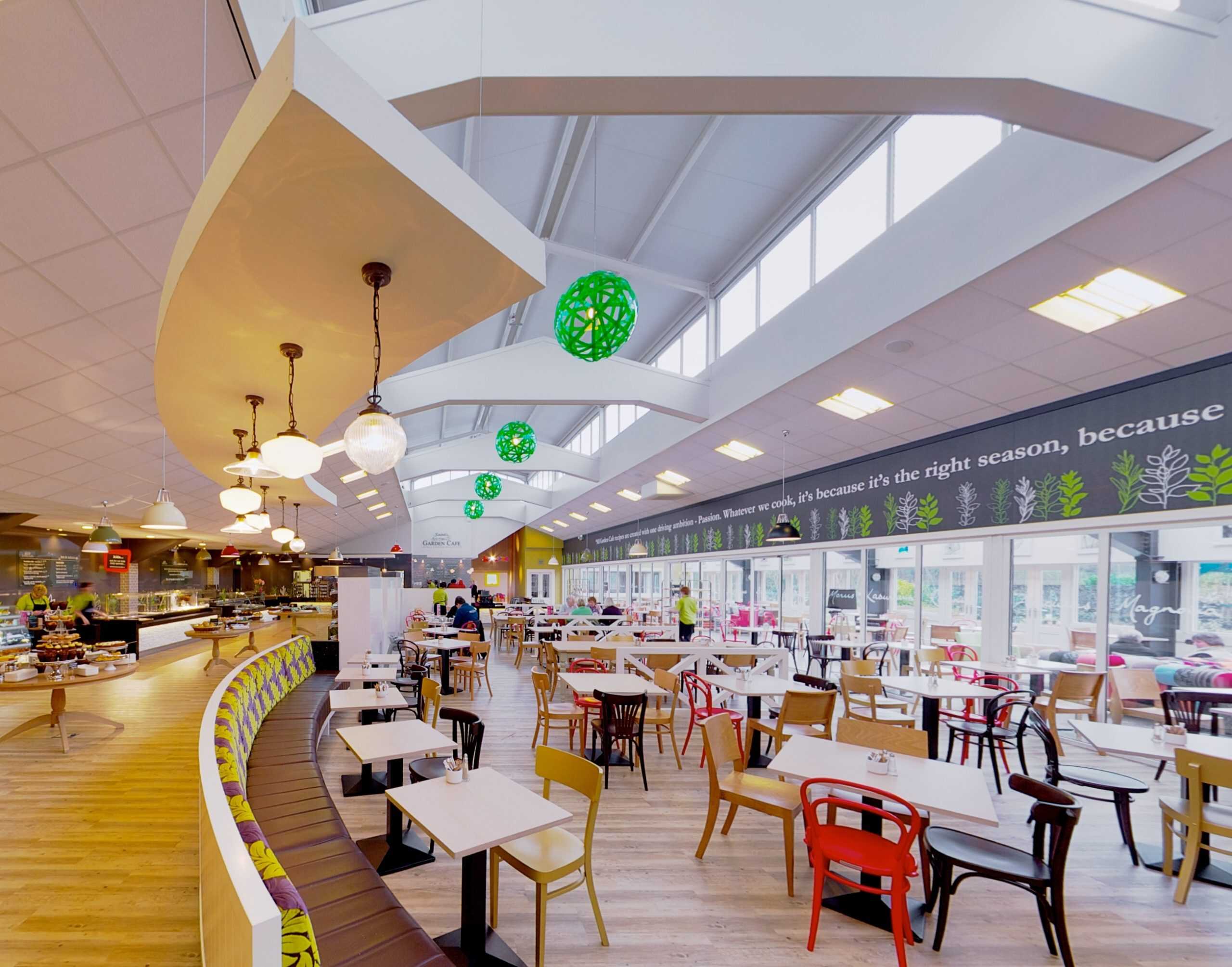
T: +353 (0) 059 9721558
THINGS TO DO BAGENALSTOWN
Bagenalstown, otherwise known in its Gaelic version as Muine Bheag is sited on a pleasant stretch of the River Barrow and derives its name from Walter Bagenal, who, in founding the town, had visions of mirroring the city of Versailles, in northern France. However, his efforts became frustrated due to the re-routing of the coach road away from the town. He left more than enough for visitors to enjoy with handsome stone public buildings including the impressive Courthouse, now a public library in Bagenalstown.
The arrival of the railway in 1846 rejuvenated the town, and its neo-classical railway station is one of the finest in Ireland. Attributed to William Deane Butler it is constructed of limestone and granite and is a seven bay, two-storey building in an Italianate villa style. Today Bagenalstown station still retains its charm in a largely unaltered state.
This former mill town made full use of the river Barrow to transport grain, beet, coal, turf and Guinness by barge, evidence of which can be seen in its fine industrial architecture. Near the railway bridge on the R705 Borris Road is an example of the Carlow fence which consists of a decorative fence made of granite pieces, laid horizontally over vertical posts and is found nowhere else in the world.
Day Boat Trips
If you want to relax and enjoy the fantastic scenery along the River Barrow surrounded by the history that makes Bagenalstown so beautiful, there is no better way to do it than with a trip onboard An Bád Keppel. The journey of a lifetime along the man-made canal in Bagenalstown awaits visitors who will experience the story of how it all happened, and enjoy the beauty of the wildlife. It is a journey you don’t want to miss and will never forget. An Bád Keppel is operated as a community boat trip by a group of enthusiastic volunteers who are keen to share their knowledge of the beautiful River Barrow.
An Bád Keppel, Bagenalstown Trip Boat, Bagenalstown Quay, Dunleckny, Co. Carlow
M: + 353 (0) 89 974 8127
E: bookings@bagenalstowntripboat.com
W: bagenalstowntripboat.com
The Barrow Experience is a unique series of ten interconnecting gardens which bring to life the history, folklore and heritage of the beautiful Barrow Valley. It is situated in the grounds of BEAM Services, a training centre for people with intellectual disabilities, on a picturesque site that bounds the canal off the River Barrow. There are ten individual gardens within the Barrow Experience – Dinn Righ, Druids’ Wood, Potager Garden, Monastic Courtyard, Convent Garden, Reflective Garden, Water Garden, Co-operation Garden, Mindfulness Garden and the French Garden. The gardens represent both an active, healthy environment for our members to work in, and a therapeutic environment to relax in – along with the general public, who are always welcome.
BEAM – The Barrow Experience Garden, Barrow Lane, Regent Street, Bagenalstown, Co. Carlow R21 AH73
T: + 353 (0) 87 122 3453 (John Murphy)
Pitch & Putt
This club was established in 1963 and is set over five picturesque acres allowing plenty of room for the odd stray shot! The course comprises 18 holes with various lengths and elevations from 32m to 70m which provide a challenge to even the most experienced players. New members are always welcome.
TYPE OF COURSE: Championship Standard 18 Hole Par 3 Pitch and Putt.
OPENING TIMES: Daylight hours all year round. MEMBERSHIP: Adult single €80, family €100, student €50 HIRE SERVICES: Clubs available by prior arrangement only
Bagenalstown Pitch & Putt, McGrath Park Sports Complex, Dunleckney, Bagenalstown, Co. Carlow, R21 FX60
M: + 353 (0) 86 153 0420 / + 353 (0) 86 7812 711
Swimming
Bagenalstown Swimming Club is a long-established voluntary club located in idyllic surroundings adjacent to the River Barrow. An ideal destination for all age groups to enjoy swimming activities in geo-thermally heated pools. A paddling pool offers younger swimmers the chance to get confident with water, the 25m pool allows all swimmers to progress and enjoy swimming in a relaxed, outdoor environment. The club also offers swimming lessons, summer camps, water safety classes, river races and swimming galas. Seasonal membership and casual rates available. All are welcome.
Bagenalstown Outdoor Swimming Pool, Leighlinbridge Road, Bagenalstown, Co. Carlow R21 RR72
E: bagenalstownswimmingpool@gmail.com
W: https://www.facebook.com/BagenalstownSwimmingPool
OPENING TIMES: Early June – Late August 11am – 12.30pm, 2.30 – 5 p.m. and 7 – 9 p.m.
Castles
If you’re eager to explore some of Carlow’s great castles then pay a visit to two, located close to Bagenalstown.
Ballymoon Castle, Ballymoon Bagenalstown – Just 3.5 km east of Bagenalstown, this ruined castle dates to the 14th century. The castle – as striking as it is unusual – comprises a courtyard about 80 feet square, surrounded by granite walls, eight feet thick and 20 feet high. Square towers project from three sides while a formidable gatehouse is the feature of the fourth. Access direct from the R724 Bagenalstown – Fenagh Road via a small timber footbridge.
Ballyloughan Castle, Bagenalstown – This castle was probably built in the 13th century and consisted of a large open courtyard with a curtain wall and a moat outside. Only a small square tower remains, as well as the entrance gate which is flanked by two large, rounded towers. The castle originally belonged to the Kavanaghs before passing into the hands of the Bagenal family of nearby Bagenalstown and following this the Bruen family in the early 19th century. The castle can be viewed from the roadside.
THINGS TO DO LEIGHLINBRIDGE
With its narrow, winding streets that rise and fall with the lie of the land, grey stone malthouses and jagged castle ruins overlooking an ancient bridge, Leighlinbridge opens a vista of Ireland’s Ancient East to the visitor. The development of Leighlinbridge Village was greatly influenced through its historic importance as a transport route.
A heritage trail takes visitors on an interesting tour around the village, highlighting key aspects of its history and heritage.
Leighlinbridge – the Garden Village
Leighlinbridge enjoys a range of gardens, built and designed by the local community to commemorate various aspects of village life over the years. These include the Millennium Garden, seven small individual gardens, each with its own theme represented by trees, shrubs and stones. The Vivaldi Garden is based on Vivaldi’s The Four Seasons while the Garden of Remembrance commemorates important occasions in the history of the village. This garden is accessible year-round and is suitable for wheelchair users. The Sculpture Garden is dedicated to three of Leighlinbridge’s most famous sons – Cardinal Patrick Francis Moran, John Tyndall and Captain Myles Keogh.
Arboretum Inspirational Gardens and Arboretum Home and Garden Heaven
A visit to Arboretum Inspirational Gardens at Arboretum Home and Garden Heaven, Leighlinbridge is a treat for the amateur and the enthusiastic gardener alike. The gardens showcase a variety of planting schemes and garden designs, all of which deliver a wow factor and yet are low maintenance. One of the great joys of gardens is colour and these gardens were designed to make the most of the positive effects of colour on our wellbeing – red for vitality, yellow for contentment, purple for knowledge, and so on. Enjoy exploring the African mud hut and spotting the friendly koi who reside in the Arboretum pond.
There is an excellent children’s playground and a maze adjacent to the Inspirational Gardens.
Meanwhile the on-site Arboretum Home and Garden Heaven is the perfect place to head to relax and take some time out. On a ten-acre site, this family-run business is a complete shopping experience – in addition to the five-star garden centre visitors will find quirky gift ideas and accessories, ladies’ fashion, Regatta outdoor wear, kitchenware, homewares and a new health and wellness department, not forgetting the award-winning Rachel’s Garden Café, where you can plan the next stage of your trip over some delicious food. Everything is made with the very best ingredients, local where possible.
Celebrating Easter – St Laserian’s Cathedral
3.5 km west of the town is Old Leighlin – 1400 years ago, Old Leighlin was a major ecclesiastical centre; today, it’s a quiet rural village in the heart of the Carlow countryside. During all this time, St Laserian’s has been a quiet witness to many profound changes. But what has not changed is the welcome it extends to everyone and the message of hope it asks them to hear. Of immense historical significance is the synod held here in c. 630 which led to the Irish church adopting the Roman calendar in defining the date of Easter. So if time permits take a little time to learn more about this fascinating, inspiring, mystifying and muchloved cathedral.
St. Laserian’s Cathedral, Old Leighlin, near Leighlinbridge, Co. Carlow R93 N598
To check opening times visit www.carlowtourism.com
Leighlinbridge to Carlow
WHERE TO STAY
Leighlinbridge area:
The Lord Bagenal Inn, Main Street, Leighlinbridge, Co. Carlow R93 E189
T: +353 (0) 59 9774000
 The Mews Self-Catering, Leighlinbridge, Co Carlow
The Mews Self-Catering, Leighlinbridge, Co Carlow
T: +353 (0) 87 2618418
Carlow area:
Avlon House Bed & Breakfast, Green Lane, Dublin Road, Carlow R93 NT26
T: +353 (0) 59 9174222
W: www.carlowbedandbreakfast.com
Dinn Rí Hotel, Tullow Street, Carlow R93 C8X5
T: +353 (0) 59 9133111
Seven Oaks Hotel and Leisure Club, Athy Road, Carlow R93 V4K5
T: +353 (0) 59 9131308
Talbot Hotel, Portlaoise Road, Carlow R93 Y504
T: +353 (0) 59 9153000
E: reservations@talbothotelcarlow.ie
Woodford Dolmen Hotel, Kilkenny Road, Carlow R93 N207
T: +353 (0) 59 9142002
E: info@woodforddolmenhotel.ie
WHERE TO EAT
Leighlinbridge area
Rachel’s Garden Café, Arboretum Home & Garden Heaven, Old Kilkenny Road, Leighlinbridge, Co. Carlow
T: +353 059 9721558
Lord Bagenal Inn, Main Street, Leighlinbridge, Co. Carlow R93 E189
T: +353 (0) 59 9774000
Carlow Town
Brooks at Dinn Rí, Tullow Street, Carlow R93 C8X5
T: +353 (0) 59 9133111
Lemongrass Restaurant, Kennedy Avenue, Carlow Town R93 A8N4
T: +353 (0)59 9139392
Lennons @ VISUAL, VISUAL Centre and George Bernard Shaw Theatre, Old Dublin Road, Carlow R93 A3K1
T: +353 (0) 59 9179245
Liberty Tree Restaurant, Talbot Hotel, Portlaoise Road, Carlow R93 Y504
T: +353 (0) 59 9153000
E: reservations@talbothotelcarlow.ie
Lotus Chinese Restaurant, Unit 2, Kennedy Avenue, Carlow R93 P7W4
T: +353 (0)59 9131986
McDonald’s, Kennedy Avenue, Carlow R93 P2Y2
T: +353 (0)59 9135460
Plum Tree Bistro & Bar, Woodford Dolmen Hotel, Kilkenny Road, Carlow R93 N207
T: +353 (0)59 9142002
E: info@woodforddolmenhotel.ie
Reddy’s Bar & Restaurant, Tullow Street, Carlow R93 FN44
T: +353 (0) 59 9142224
Supermac’s Family Restaurant & Papa John’s Pizza, Burrin Street, Carlow R93 YH79
T: (+353) 059 9130444
W: www.supermacs.ie and www.papajohns.ie
T.D. Molloy’s Restaurant, Seven Oaks Hotel, Athy Road, Carlow R93 V4K5
T: +353 (0) 59 9131308
Teach Dolmain, 76 Tullow Street, Carlow R93 NY70
T: (+353) 059 9130911
The Lazy River Café, Unit 1, Castleview Quay, Graiguecullen, Carlow R93 ET22
T: +353 (0) 59 9173588
E: thelazyrivercafe@hotmail.com
The Tullow Gate, JD Wetherspoon, 7 Tullow St., Carlow R93 YC66
T: +353 (0) 59 9142432
LEIGHLINBRIDGE – THINGS TO DO
With its narrow, winding streets that rise and fall with the lie of the land, grey stone malthouses and jagged castle ruins overlooking an ancient bridge, Leighlinbridge opens a vista of Ireland’s Ancient East to the visitor. The development of Leighlinbridge Village was greatly influenced through its historic importance as a transport route.
A heritage trail takes visitors on an interesting tour around the village, highlighting key aspects of its history and heritage.
Leighlinbridge – the Garden Village
Leighlinbridge enjoys a range of gardens, built and designed by the local community to commemorate various aspects of village life over the years. These include the Millennium Garden, seven small individual gardens, each with its own theme represented by trees, shrubs and stones. The Vivaldi Garden is based on Vivaldi’s The Four Seasons while the Garden of Remembrance commemorates important occasions in the history of the village. This garden is accessible year-round and is suitable for wheelchair users. The Sculpture Garden is dedicated to three of Leighlinbridge’s most famous sons – Cardinal Patrick Francis Moran, John Tyndall and Captain Myles Keogh.
Arboretum Inspirational Gardens and Arboretum Home and Garden Heaven
A visit to Arboretum Inspirational Gardens at Arboretum Home and Garden Heaven, Leighlinbridge is a treat for the amateur and the enthusiastic gardener alike. The gardens showcase a variety of planting schemes and garden designs, all of which deliver a wow factor and yet are low maintenance. One of the great joys of gardens is colour and these gardens were designed to make the most of the positive effects of colour on our wellbeing – red for vitality, yellow for contentment, purple for knowledge, and so on. Enjoy exploring the African mud hut and spotting the friendly koi who reside in the Arboretum pond.
There is an excellent children’s playground and a maze adjacent to the Inspirational Gardens.
Meanwhile the on-site Arboretum Home and Garden Heaven is the perfect place to head to relax and take some time out. On a ten-acre site, this family-run business is a complete shopping experience – in addition to the five-star garden centre visitors will find quirky gift ideas and accessories, ladies’ fashion, Regatta outdoor wear, kitchenware, homewares and a new health and wellness department, not forgetting the award-winning Rachel’s Garden Café, where you can plan the next stage of your trip over some delicious food. Everything is made with the very best ingredients, local where possible.
Celebrating Easter – St Laserian’s Cathedral
3.5 km west of the town is Old Leighlin – 1400 years ago, Old Leighlin was a major ecclesiastical centre; today, it’s a quiet rural village in the heart of the Carlow countryside. During all this time, St Laserian’s has been a quiet witness to many profound changes. But what has not changed is the welcome it extends to everyone and the message of hope it asks them to hear. Of immense historical significance is the synod held here in c. 630 which led to the Irish church adopting the Roman calendar in defining the date of Easter. So if time permits take a little time to learn more about this fascinating, inspiring, mystifying and muchloved cathedral.
St. Laserian’s Cathedral, Old Leighlin, near Leighlinbridge, Co. Carlow R93 N598
To check opening times visit www.carlowtourism.com
THINGS TO DO CARLOW
Carlow Town, the county capital is strategically positioned at the meeting point of the Rivers Barrow and Burrin. Here the visitor is presented with a rich tapestry of history dating back a millennium and beyond, many associated famous names and an architectural heritage telling the story of the town’s evolution since the Normans first came here in the 12th century. With a population of over 20,000, Carlow is the county town and gateway to the South-East standing at the confluence of the Barrow and Burrin rivers. Tradition has it that the junction of the two rivers once covered such a large area of ground that a lake was formed, or, as some believe four lakes, hence the name Ceatharloch or City of the Four Lakes.
Famous names associated with Carlow include George Bernard Shaw, the dramatist and critic whose mother Lucinda Elizabeth Gurley was born in Carlow. The famous impressionist artist Frank O’Meara was born at 37 Dublin Street on March 30th 1853, sharing that birth date with Vincent Van Gogh.
Carlow Garden Trail
An Gairdín Beo
An Gairdín Beo is a two-acre community garden in the centre of Carlow Town, where people both work, and then reap the rewards together. The overall vision of the project is to have a space in which diverse people can connect to nature, to growing and making food, and to each other. The ethos of the garden is based on an ecological orientation: on valuing diversity, sustainability and indigenous species.
Events are held throughout the year using produce from the gardens, and all members of the community are welcome to attend.
An Gairdín Beo, Dublin Road, Carlow
E: carlowcommunitygarden@gmail.com
Delta Sensory Gardens
The Delta Centre was established in 1990 from humble beginnings as an adult centre for people with intellectual disabilities. The centre now caters to 127 adults with disabilities.
The Sensory Gardens, which were officially opened in 2007, were the first of their kind in Ireland. Originally created with a therapeutic focus as benefit for the centre’s own residents, they are now a major attraction in Carlow. An oasis of peace and tranquillity, the Delta Sensory Gardens feature 16 interconnecting gardens set on 2.5 acres, just outside of Carlow town. Visitors can stroll and admire the beautiful limestone sculptures throughout the gardens, bask in the tranquillity of the water features and marvel at the one tonne piece of pink marble floating on a cushion of water.
These beautiful gardens have come about with the help from renowned and award-winning designers, including Gordon Ledbetter, Mary Reynolds, Rachel Doyle, Elma Fenton and Paul Martin. The gardens offer visitors a unique opportunity to rest and indulge their senses of touch, taste, smell, hearing and visual delight. The on-site garden centre has lots of seasonal colour year-round, with plenty of pots, containers and bedding. A selection of seasonal gifts are available in the gift shop. Café Thyme has become a popular meeting place for individuals and small groups for a quiet chat, with many regulars now enjoying the beautiful food on offer. Coffee and snacks, lunches and afternoon teas are available in a relaxing atmosphere.
Delta Centre and Gardens host many events throughout the year. Some are well-established and have seen great success over the years, including Daffodil Week in March, the Carlow Garden Festival at the end of July and the Christmas lights display and Sensory Santa in December.
Delta Sensory Gardens and Garden Centre, Strawhall Estate, Carlow, R93 Y959
T: +353 (0) 59 914 3527
E: info@deltasensorygardens.com
W: www.deltasensorygardens..com
Brownshill Dolmen
One very unmistakable monument dating back to pre-historical times is the great dolmen at Brownshill to the east of Carlow Town. The dolmen has a granite capstone weighing over 100 tonnes, making it the largest of its kind in Europe. The massive capstone rests on two portal stones which flank a door stone and slopes downwards to the west where it rests on a low boulder. This magnificent capstone has excited the interest of many antiquarians and tourists down through the years and it is thought that religious rites, possibly even human sacrifice, were performed there for four and a half thousand years (2500 B.C.).
Signposted, direct access – 5km from Carlow Town on the R726 Hacketstown Road.
Carlow Castle
Located at the meeting of the Rivers Barrow and Burrin, the castle had four 25 feet thick towers and stood three storeys high, making it a strategic fortress which protected the river crossing and Carlow Town. It was built in the 13th century by William Marshal, Earl of Pembroke and Lord of Leinster who had succeeded Strongbow, leader of the Norman invasion of Ireland. From 1391 – 1395 the Exchequer and Court of Common Pleas were located in and around the castle, thus making Carlow the capital of Ireland for this period. It remained relatively unscathed until 1814 when Dr Midleton, accidentally blew it up during works to convert it into an asylum with the only the west wall and two towers remaining.
Carlow County Museum
When in Carlow Town make sure to pay a visit to the multi award-winning Carlow County Museum, which offers a fascinating insight into the heritage and history of this inland town and county. There is so much to discover here – among the many displays are exhibitions featuring: the magnificently hand-carved 19th century wooden pulpit from Carlow Cathedral, one of the top 100 objects to view in an Irish museum; the gallows trap door from Carlow Gaol used in 19th century public executions; an exhibition on the Carlow Sugar Factory, Ireland’s first and largest sugar factory, which was opened in 1926; the wonderful stained glass panel by Peadar Lamb commemorating the 1916 Rising and its Carlow links; archaeological finds from the Carlow M9 bypass including the country’s first ring brooch, courtesy of the National Museum of Ireland and Transport Infrastructure Ireland.
Find out about some of Carlow’s personalities; see the remains of Kevin Barry’s last cigarette and his death mask, with both items dating from the time of his execution in Mountjoy Gaol, Dublin at the age of just 18 for his role in the Irish War of Independence; the wooden smoking pipe of Captain Myles Keogh of the 7th US Cavalry who was killed in the infamous battle of Little Big Horn along with General Custer in 1876; John Tyndall, Carlow’s prolific 19th century scientist whose discoveries, including the greenhouse effect still have an impact to this day.
Carlow County Museum, College Street, Carlow
T: +353 (0) 59 9131554
Carlow Farmers Market
Carlow Farmers’ Market is widely recognised as one of the best run producer markets in the country. It has proven hugely popular as customers embrace its unique and relaxed ambience and the wide variety of fresh fruit, vegetables, meats, juices and home baking on offer.
Also available are organic meats, cheeses, juices, jams, chutneys, free-range and farm fresh eggs. The wide selection of home baking includes gluten-free and spelt products, other options include raw food, wheat grass and a selection of food to go. Fresh flowers and bedding plants are also on sale in season. There is a shared craft stall which rotates between pottery and other craft items.
With a casual yet intimate atmosphere, the market is a great place to spend a Saturday morning while purchasing excellent local produce.
HOW TO FIND US: Every Saturday, Potato Market and Liberty Tree, Carlow Town
OPENING TIMES: Saturdays, 9am – 2pm
ADMISSION: Free
Carlow Farmer’s Market, Potato Market, Carlow
T: +353 (0) 87 2738061
W: www.carlowfarmersmarket.com
County Carlow Military Museum
This museum is dedicated to the collection, preservation and display of military memorabilia heritage. All artefacts are donated by families of former service men and women and show their careers involving local, national and international events in which they participated. A range of over 4,500 items cover all periods from Carlow Castle, 1798 Rebellion, 1916 Rising and World War One and Two. Extensive reference material can be used by school groups, tourists, authors and researchers.
HOW TO FIND US: Immediately off the Athy Road in Carlow Town on the grounds of St Dympna’s Hospital.
OPENING TIMES: St Patrick’s Day, Thursday, March 17th 2pm-5pm; Friday, March 18th 2-5pm; Sunday, March 20th 2pm-5pm. Each following Sunday until Sunday, November 11th 2pm-5pm. Also, each following Monday, Wednesday and Friday beginning Monday March 21st until Friday, November 11th from 11am-4pm
Co. Carlow Military Museum, Old Church, Athy Road, Carlow R93 PK46
T: +353 (0) 87 6904242
W: www.carlowmilitarymuseum.eu
Duckett’s Grove Historic House, Walled Gardens and Pleasure Grounds
Duckett’s Grove, the 18th, 19th and early 20th century home of the Duckett family, was formerly at the centre of a 20,000 acre (8,093 hectares) estate that has dominated the Carlow landscape for over 300 years. Even in ruin, the surviving towers and turrets of Duckett’s Grove form a romantic profile making it one of the most photogenic historic buildings in the country. This part Cobden designed building is structurally intact and accessible to the public.
Two Georgian kitchen gardens form part of the complex where the old paths have been revealed and the beds and borders reinstated. The courtyard area features a craft studio occupied by an artisan craft maker Elaine Kelly of NicAngels Candles, who specialises in individual, hand-marbled, fragrance-free Irish made candles. NicAngels Candles are open on selected days during the week. This project forms part of the Ireland’s Ancient East tourism trail.
Duckett’s Grove Historic House, Walled Gardens and Pleasure Grounds, Kneestown, near Carlow Town R93 RF80
Hours: Open daylight hours, all year
T: +353 (0) 59 9131554
VISUAL and George Bernard Shaw Theatre
This stunning building in the heart of Carlow Town presents artwork by national and international artists in a location which is recognised as Ireland’s largest and most spectacular space for art. There are lots of activities to enjoy including family art workshops, youth theatre, talks, workshops, tours, plus a 320-seat theatre with a packed programme of drama, film, dance and comedy.
OPENING HOURS: Tuesday-Saturday 11am-5.30pm Sunday 2pm-5pm Box Office is also open one hour before all events.
VISUAL, Old Dublin Road, Carlow R93 A3K1
T: +353 (0) 59 9172400
